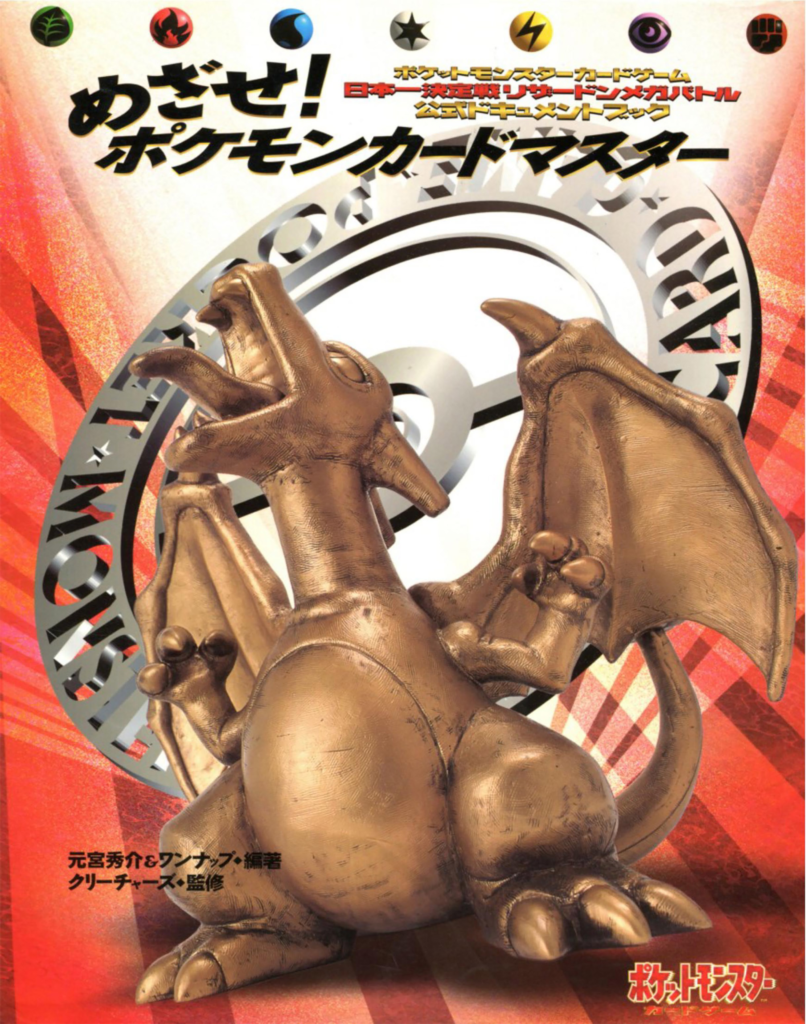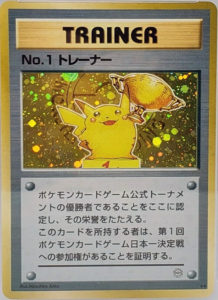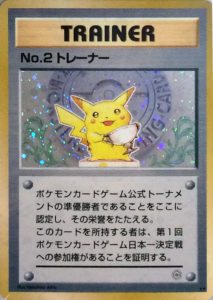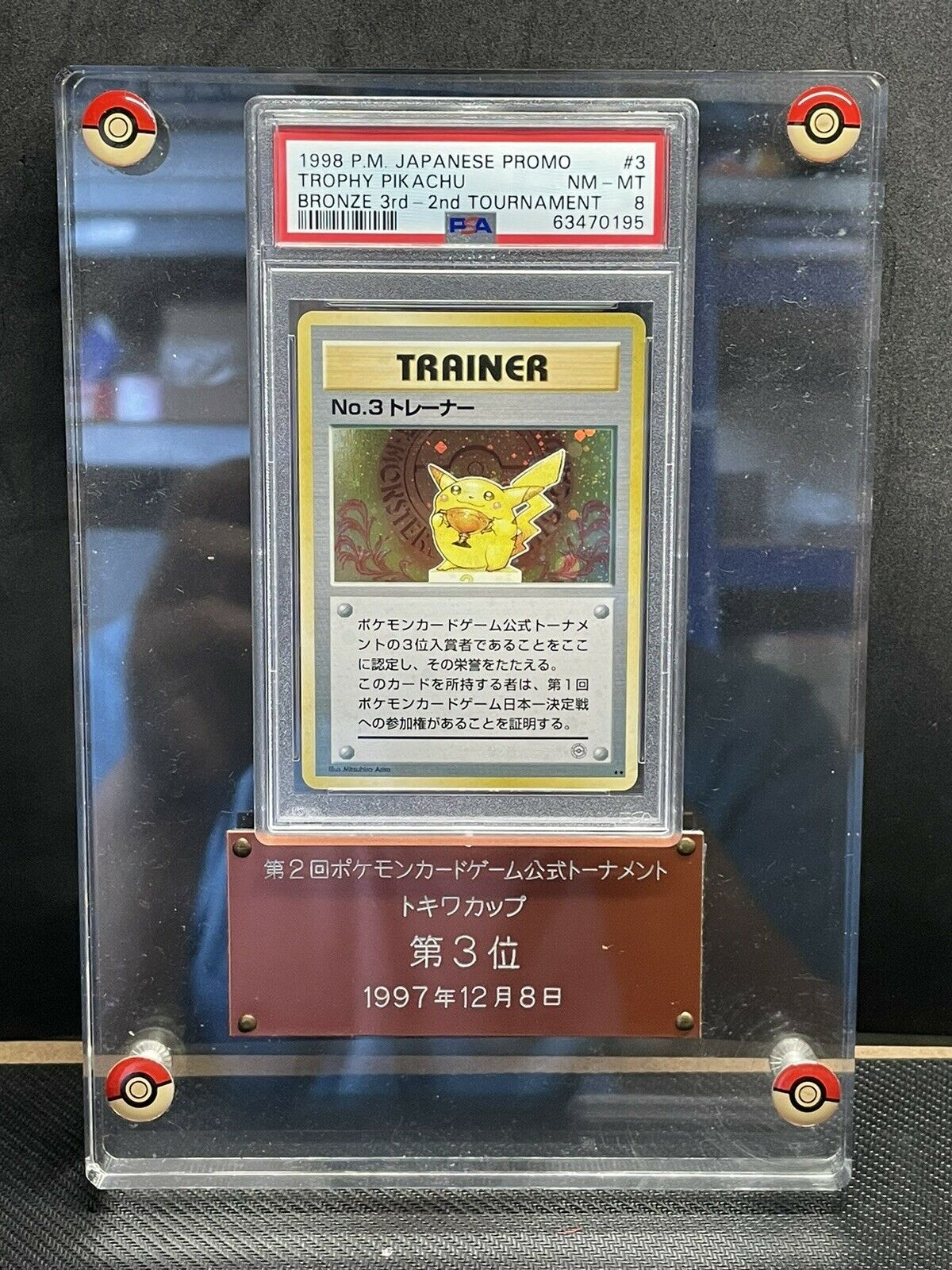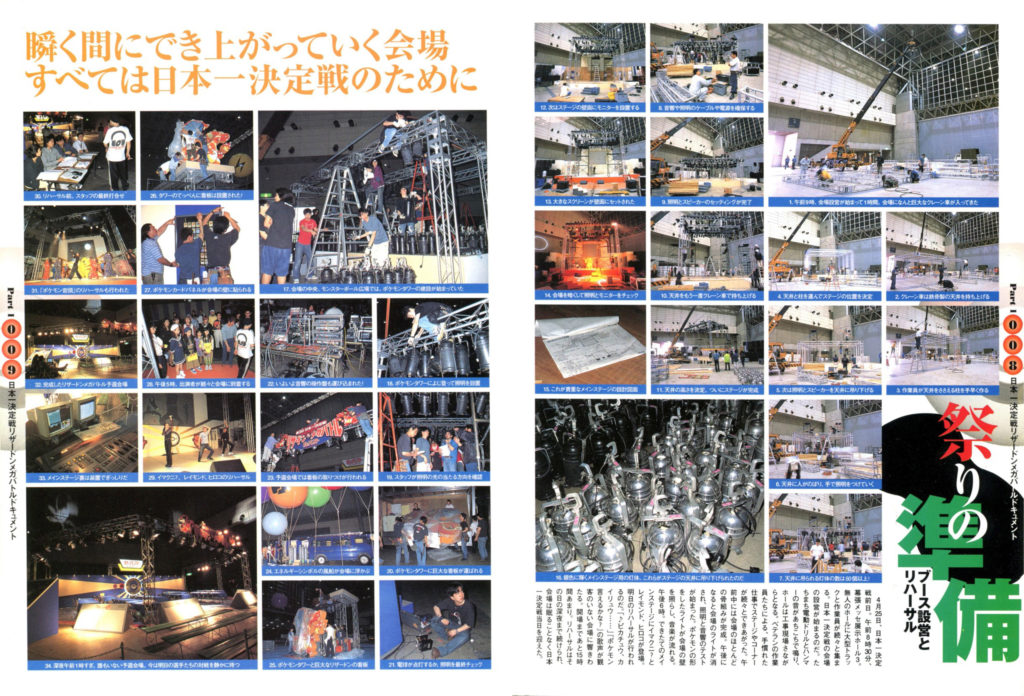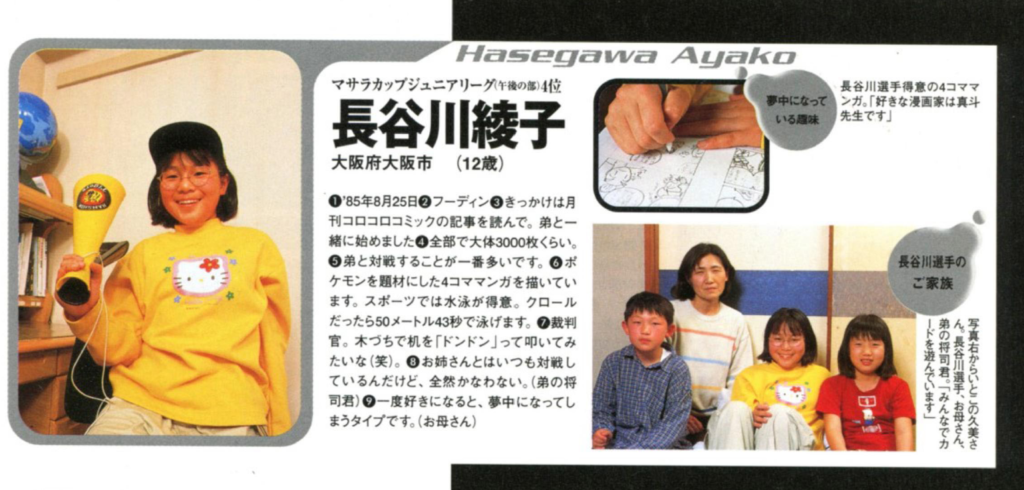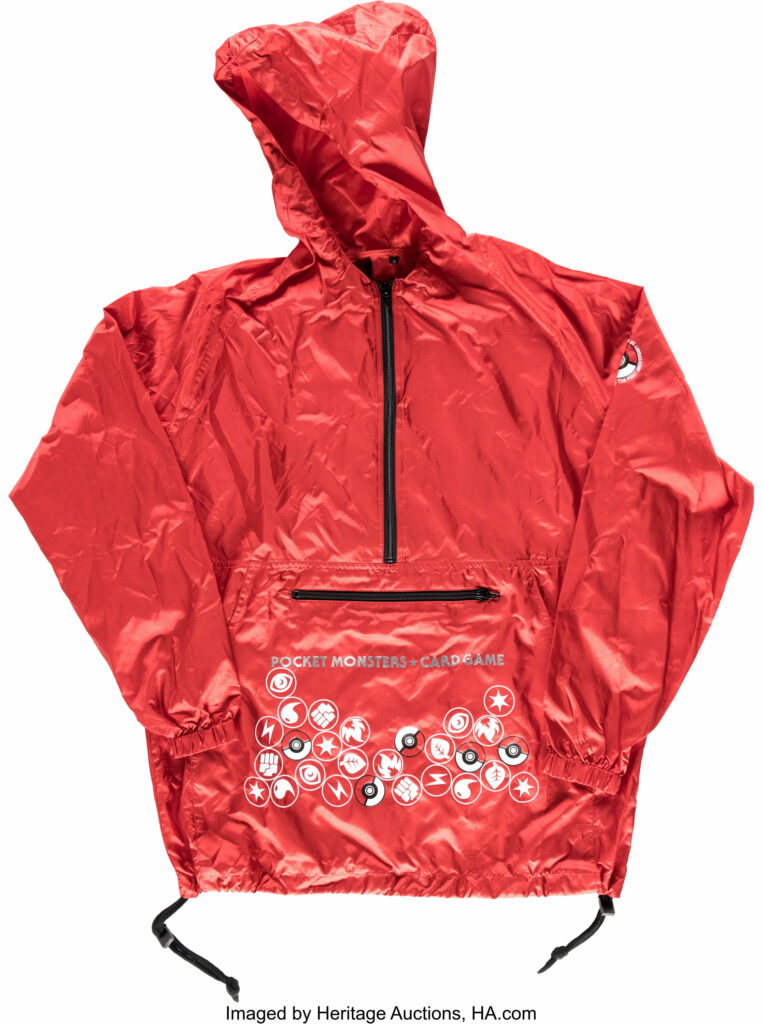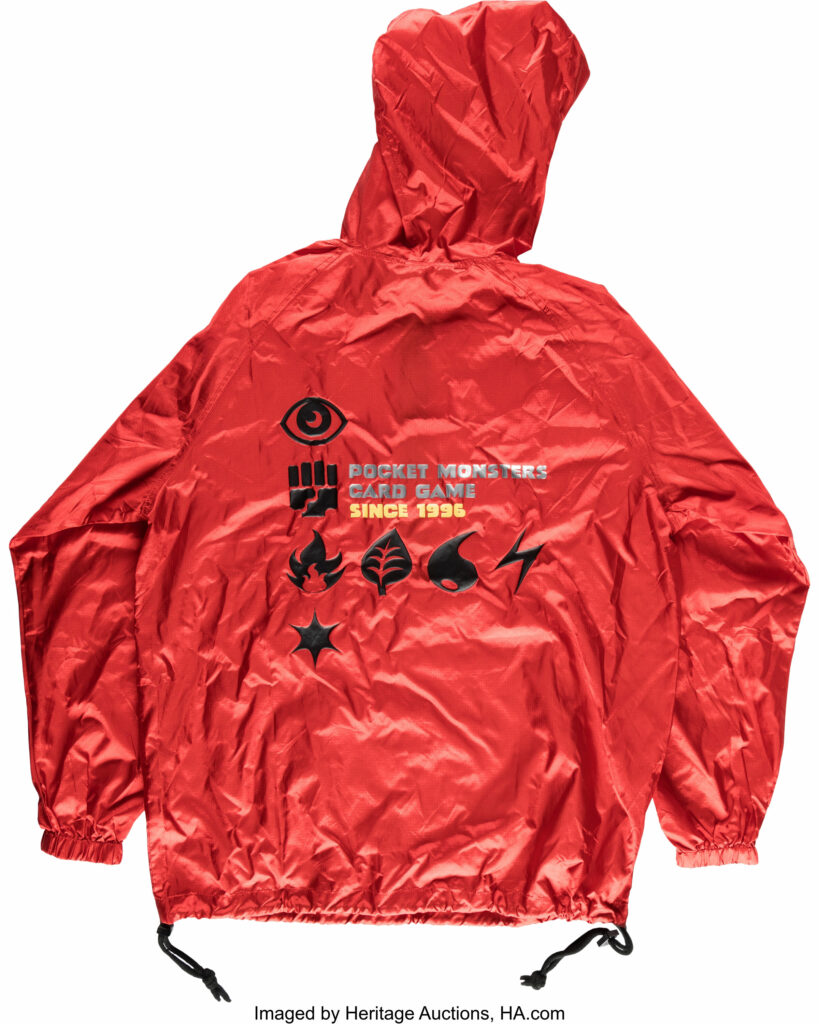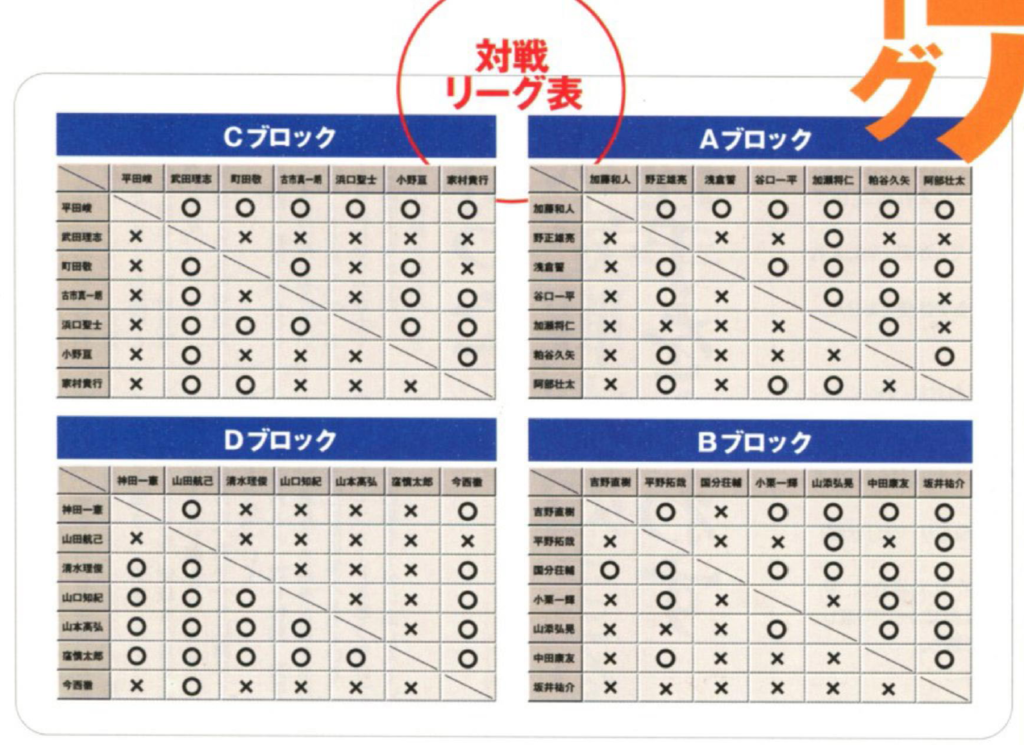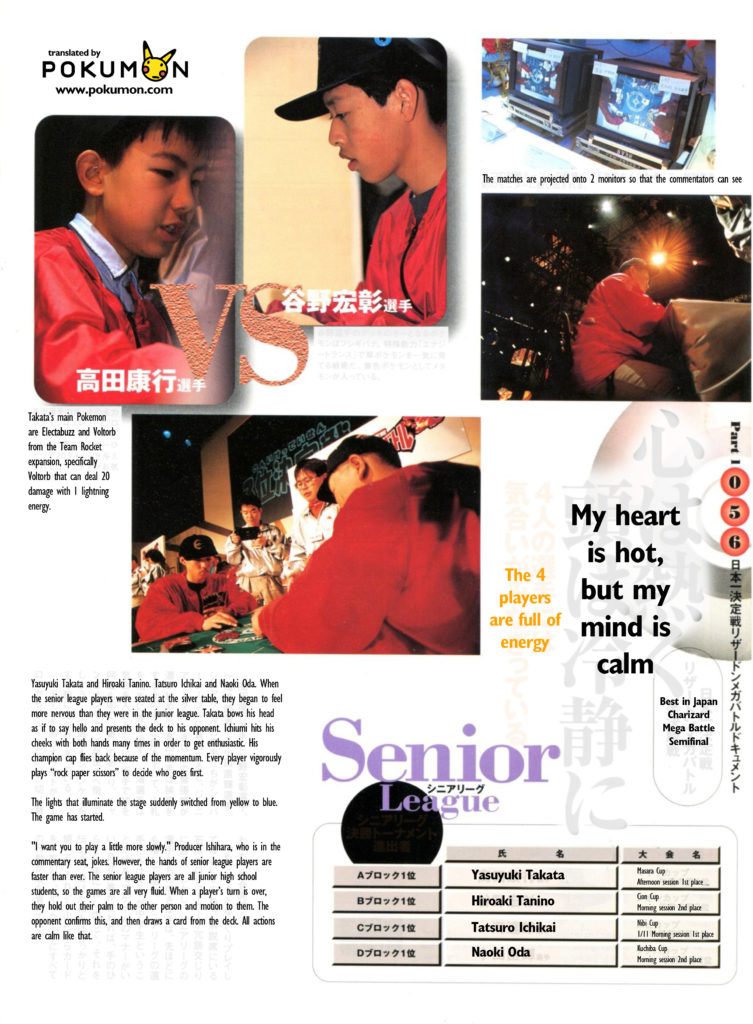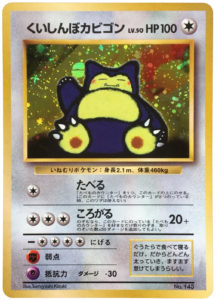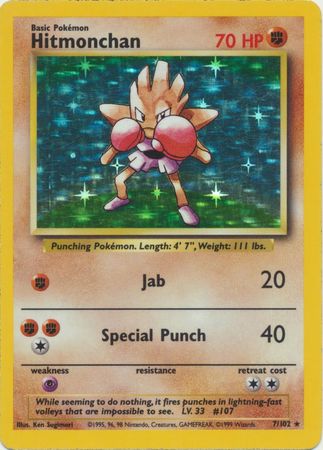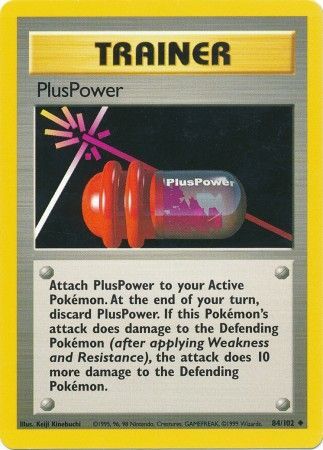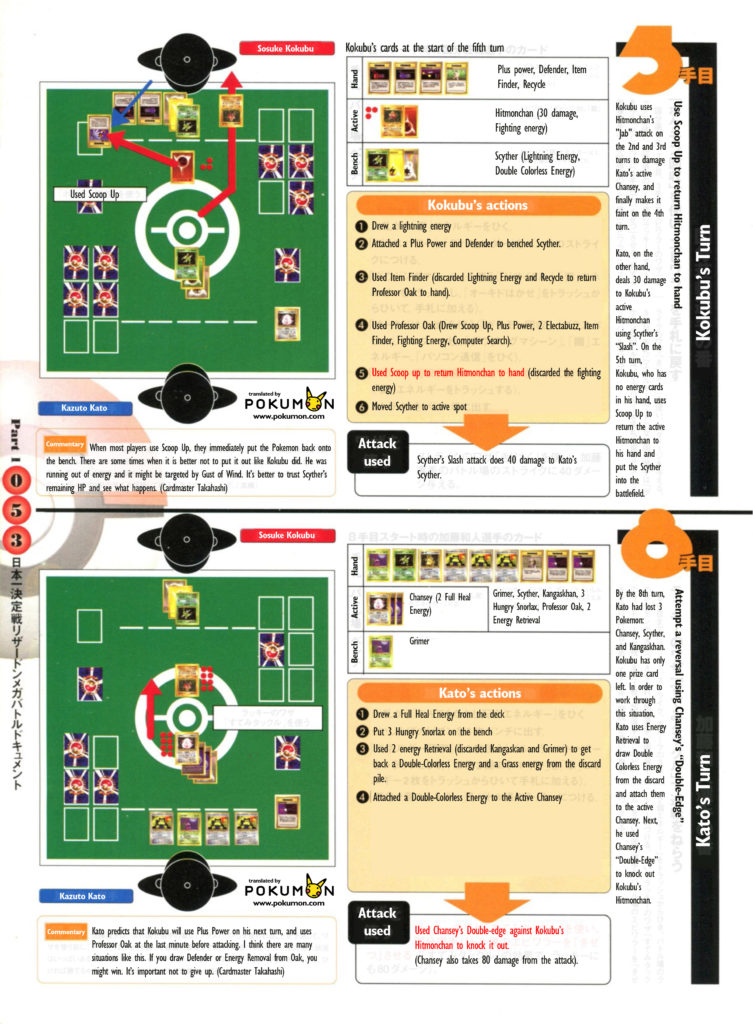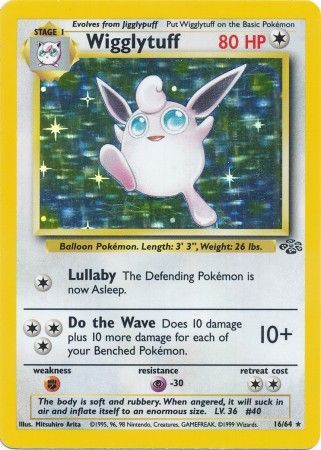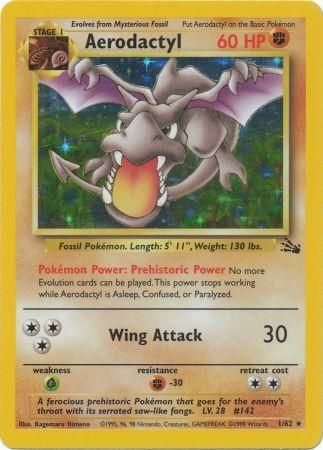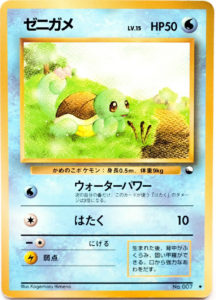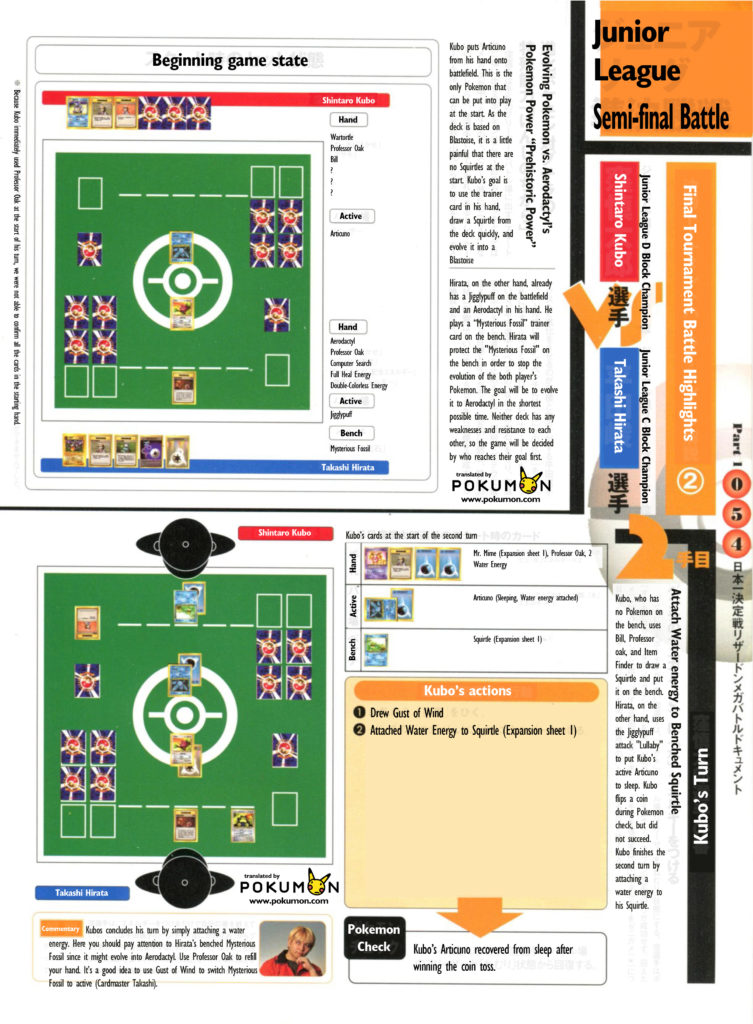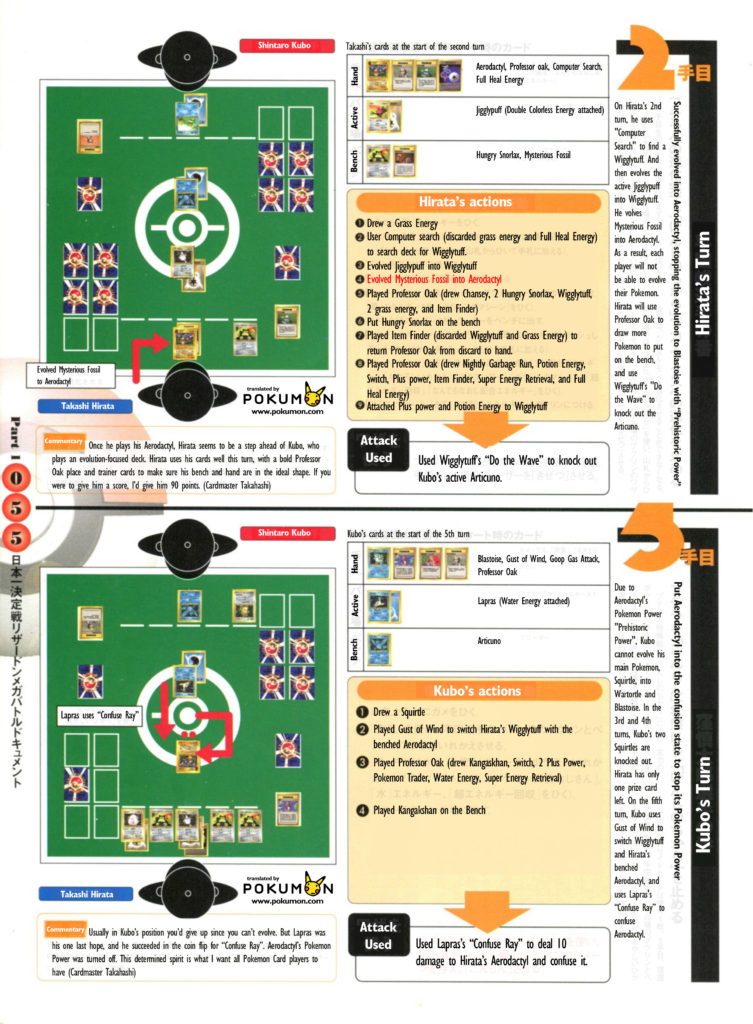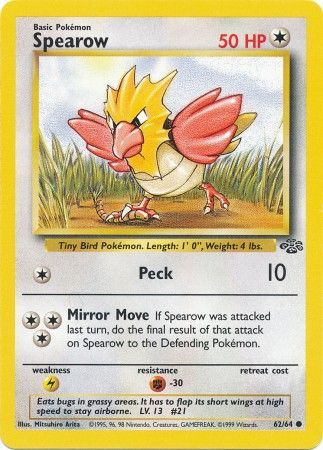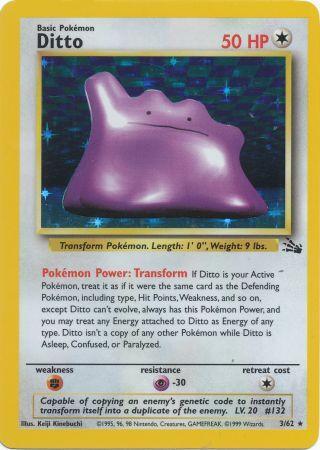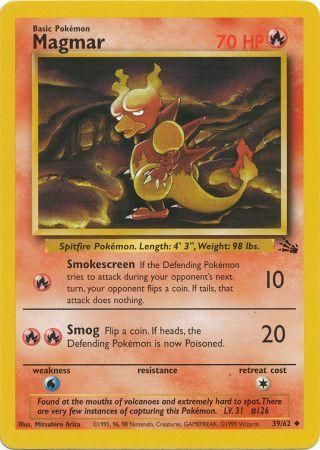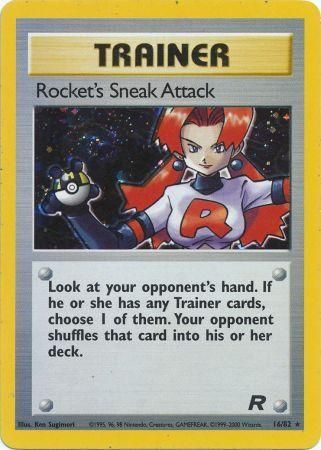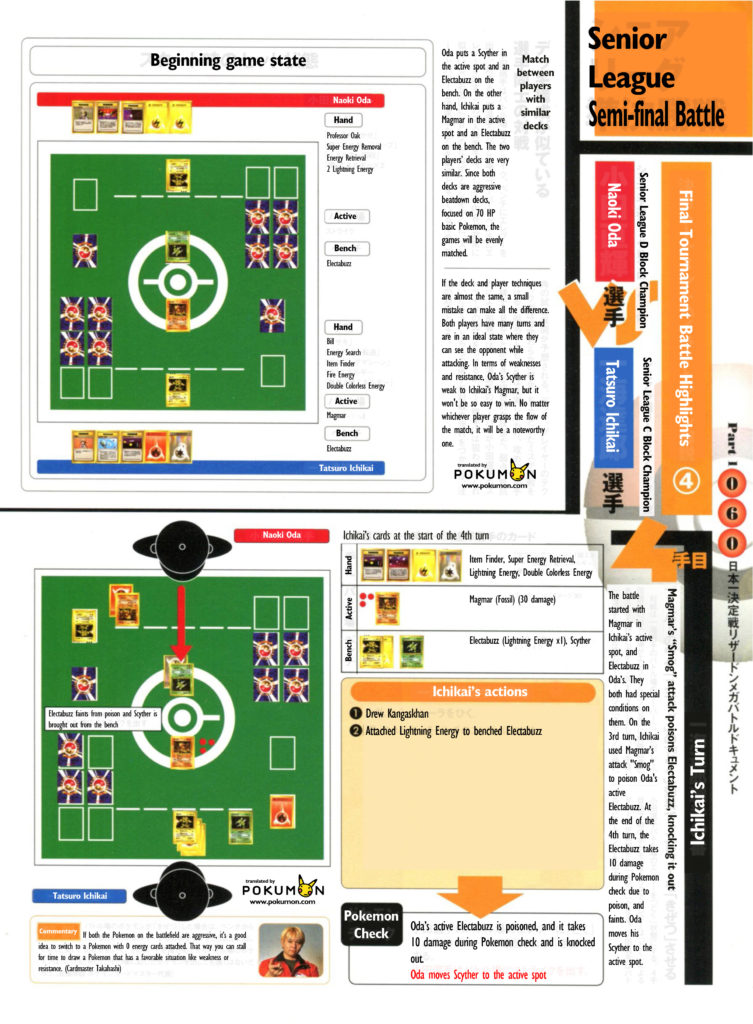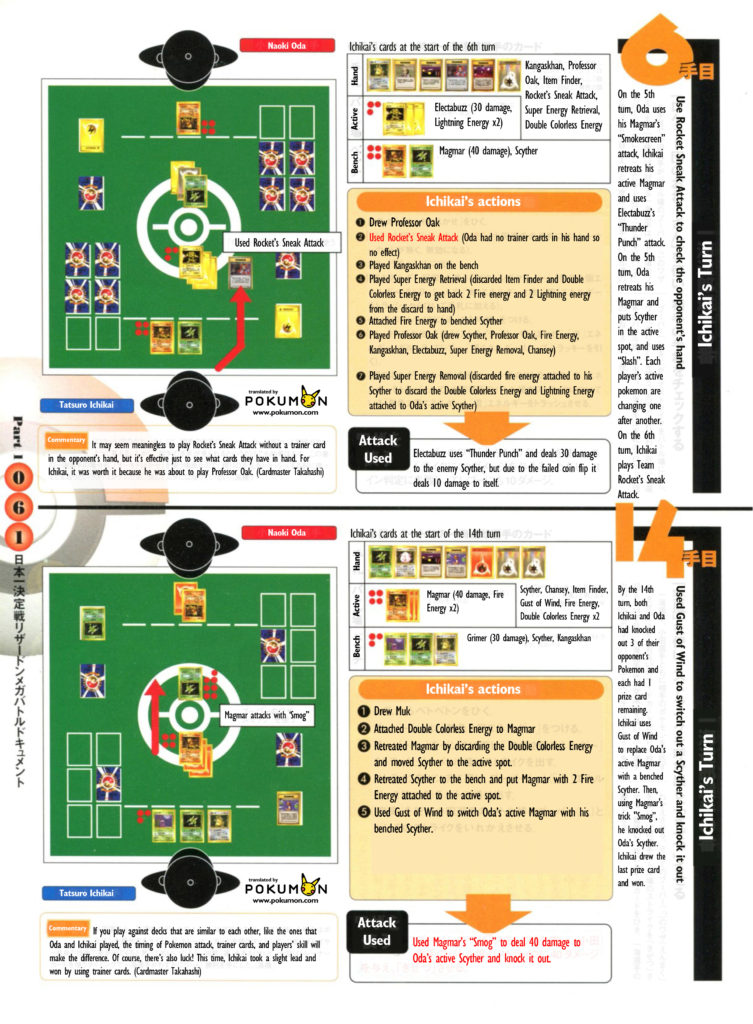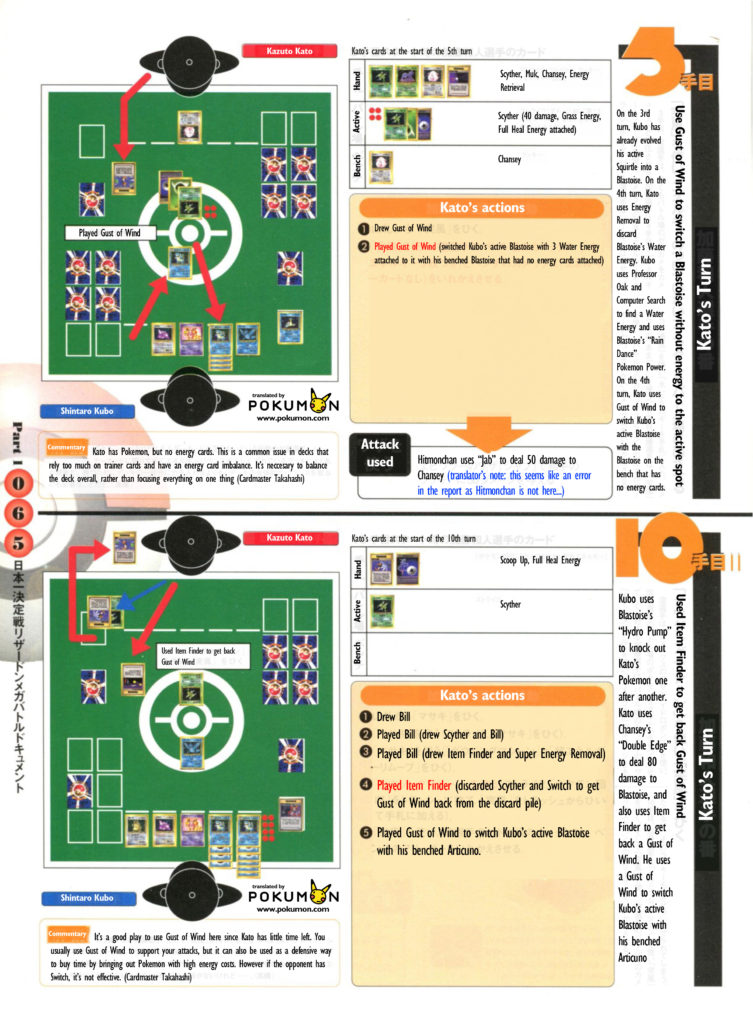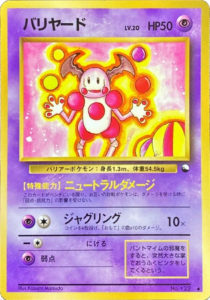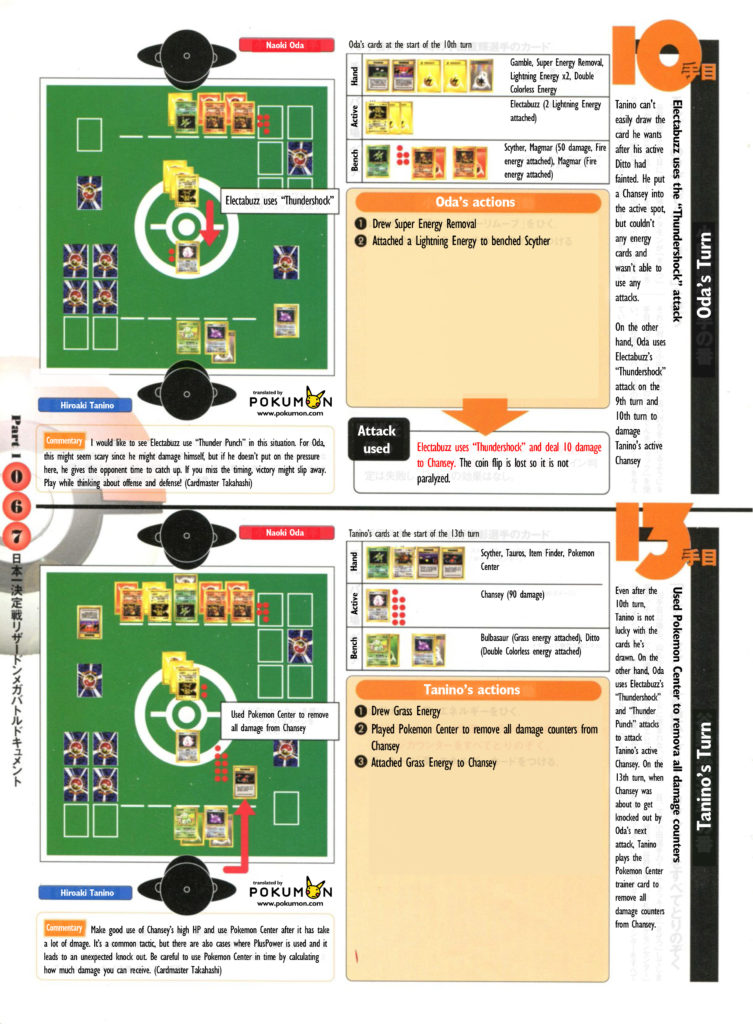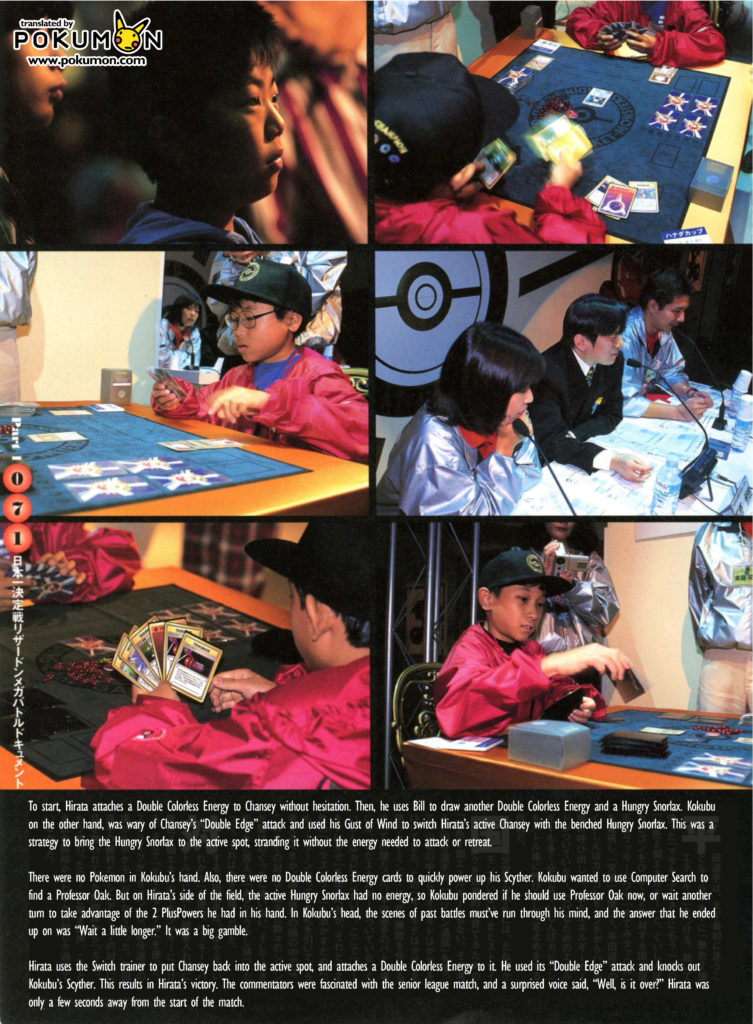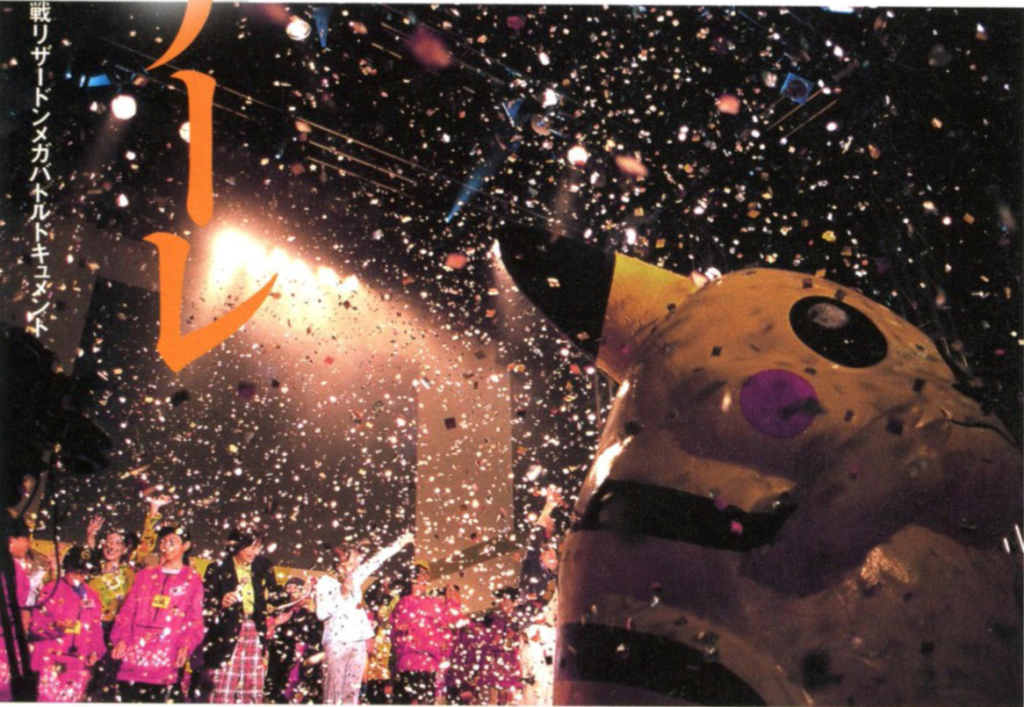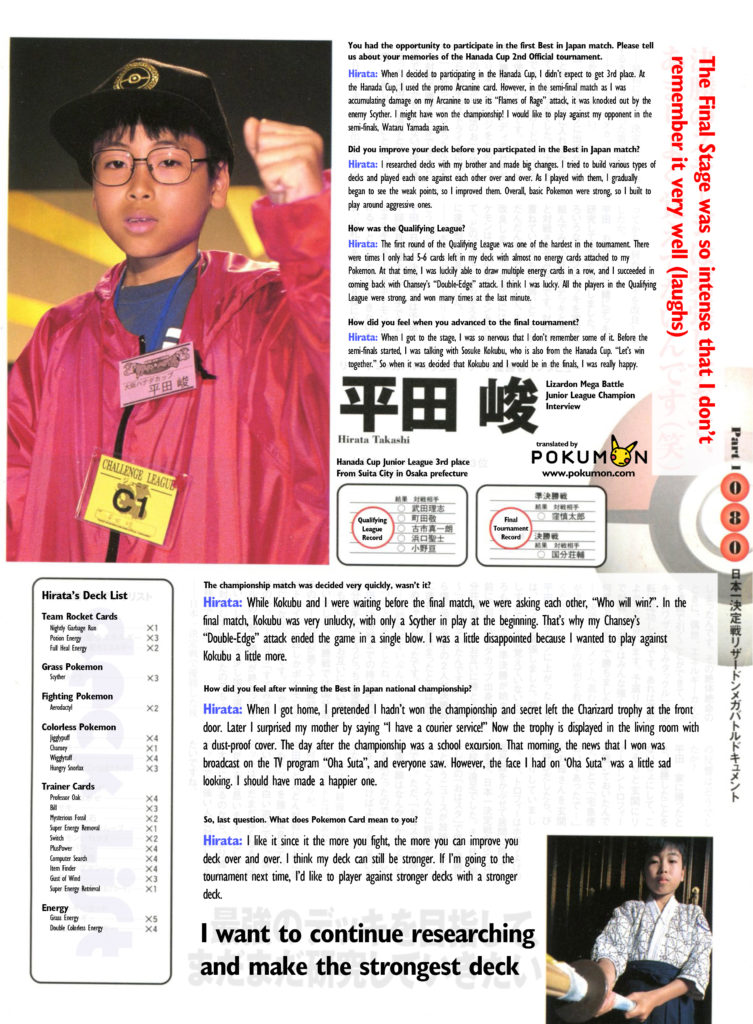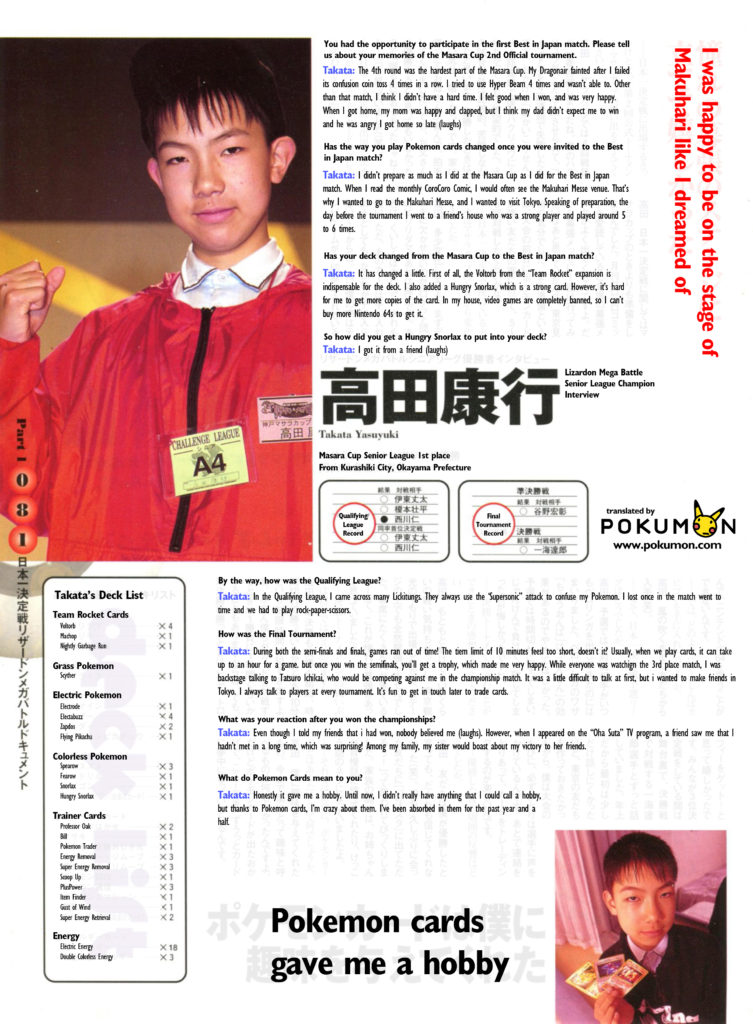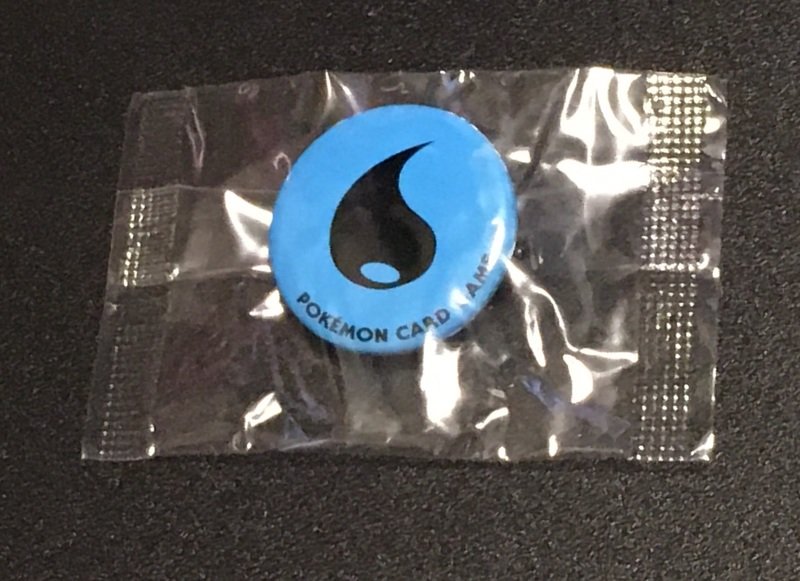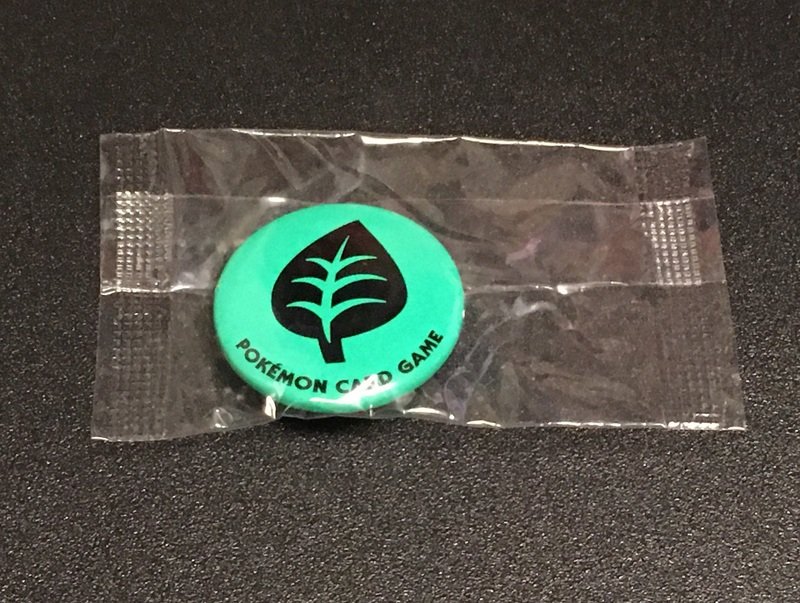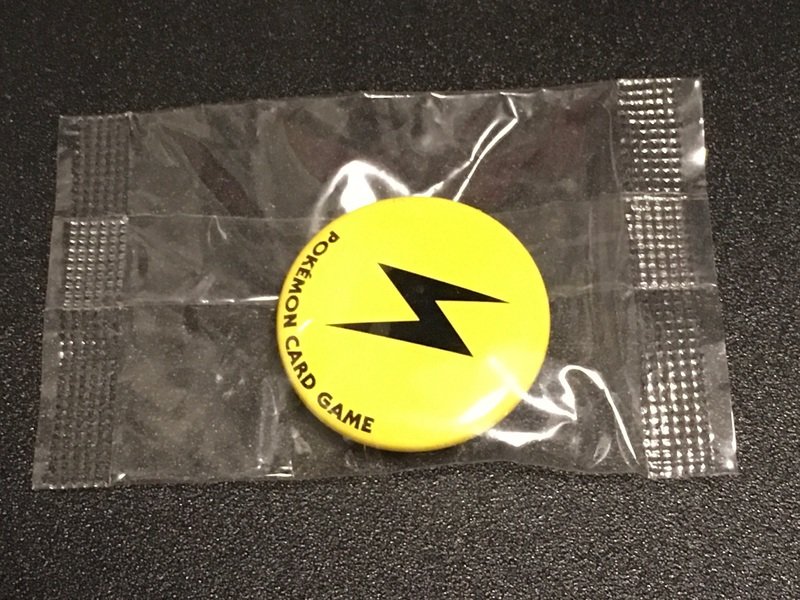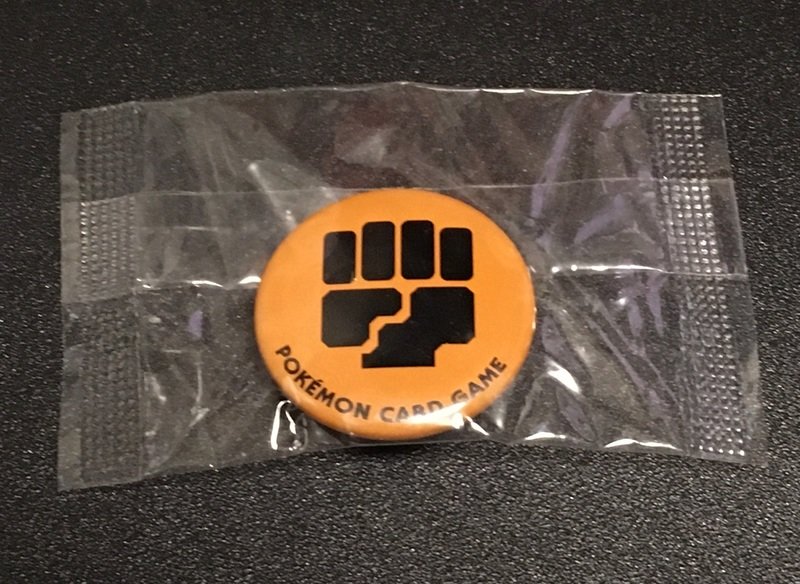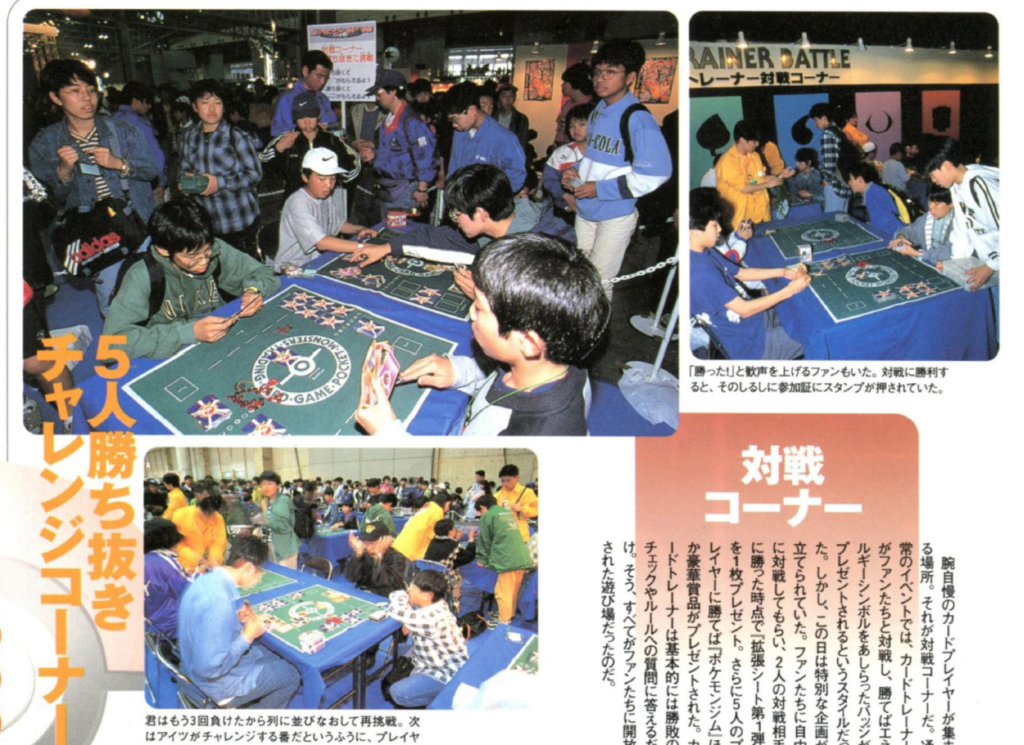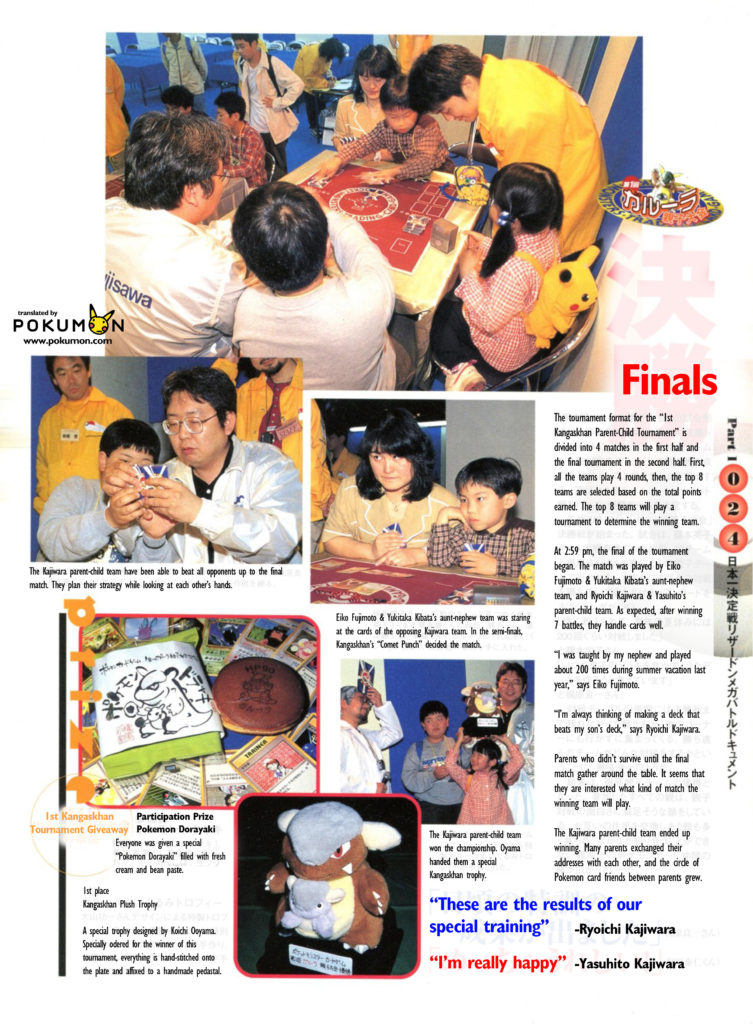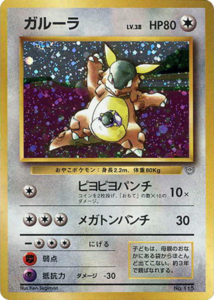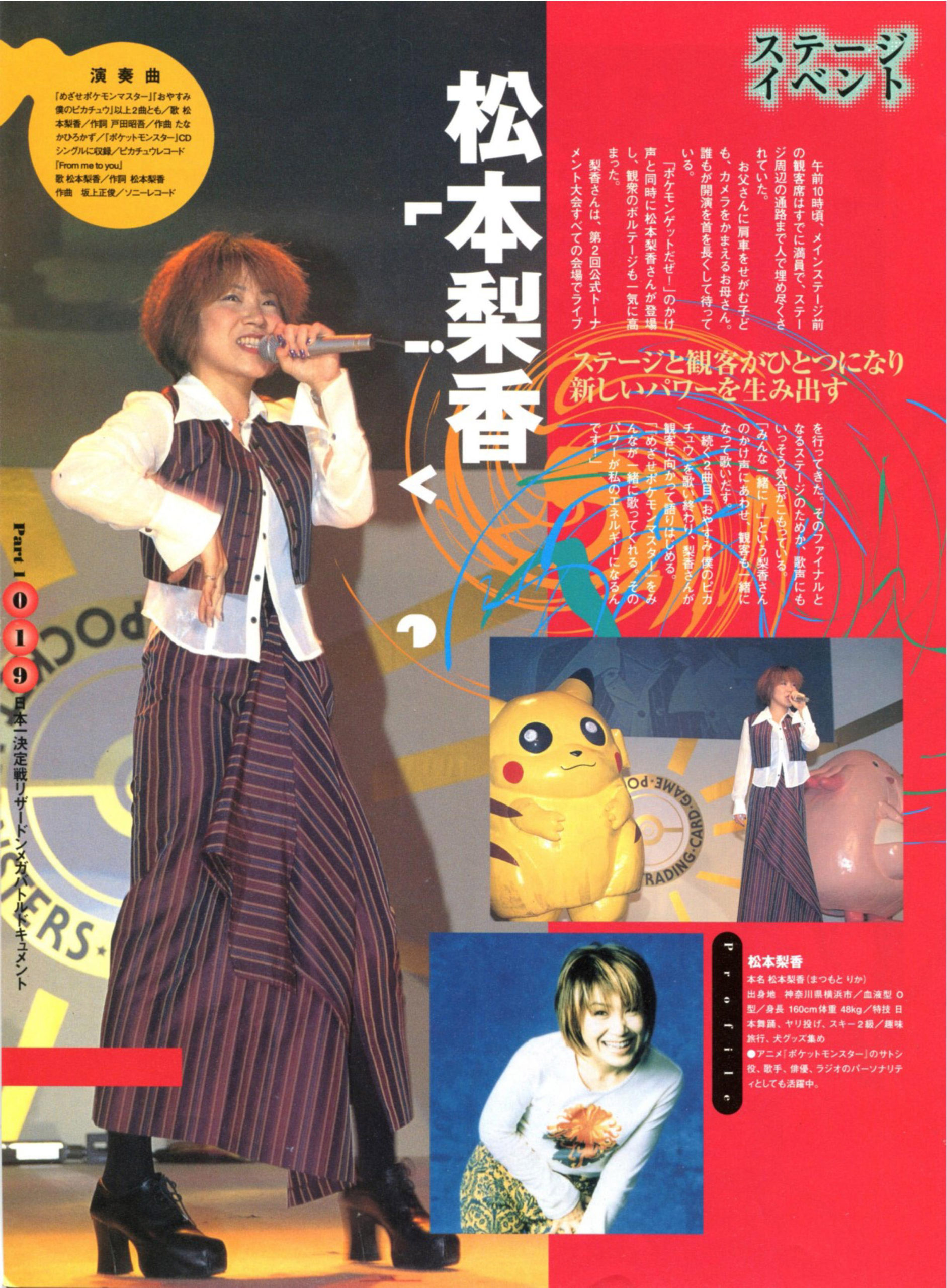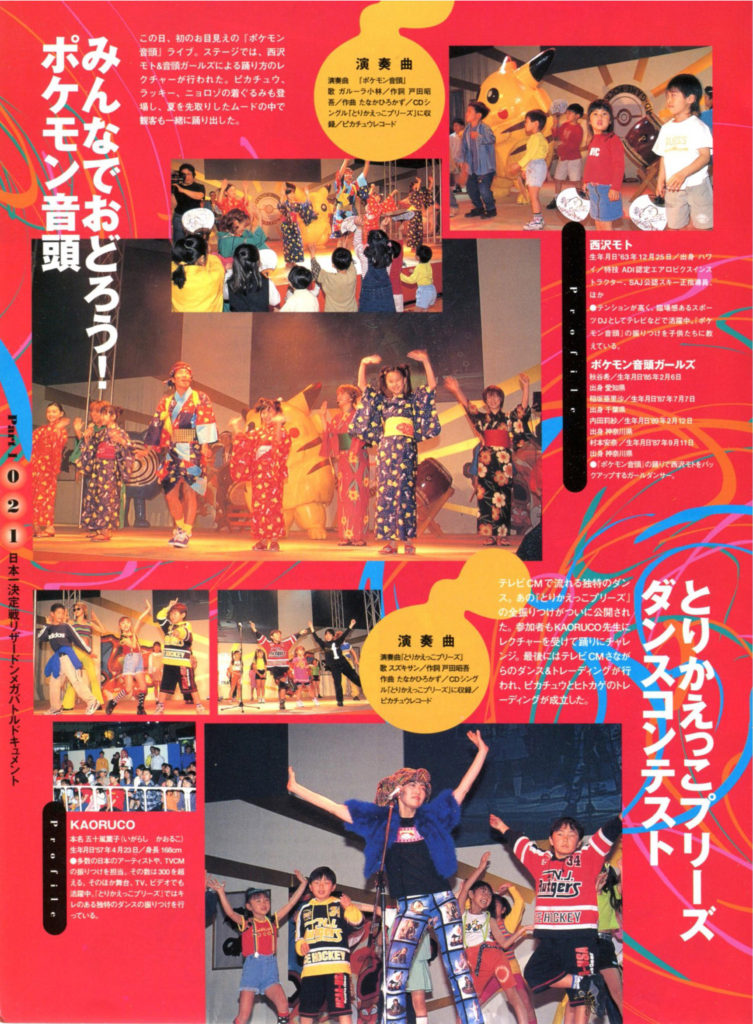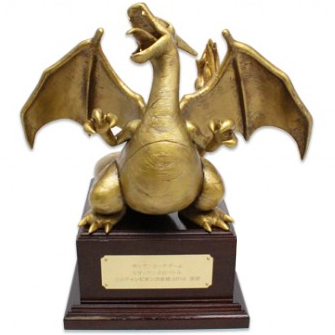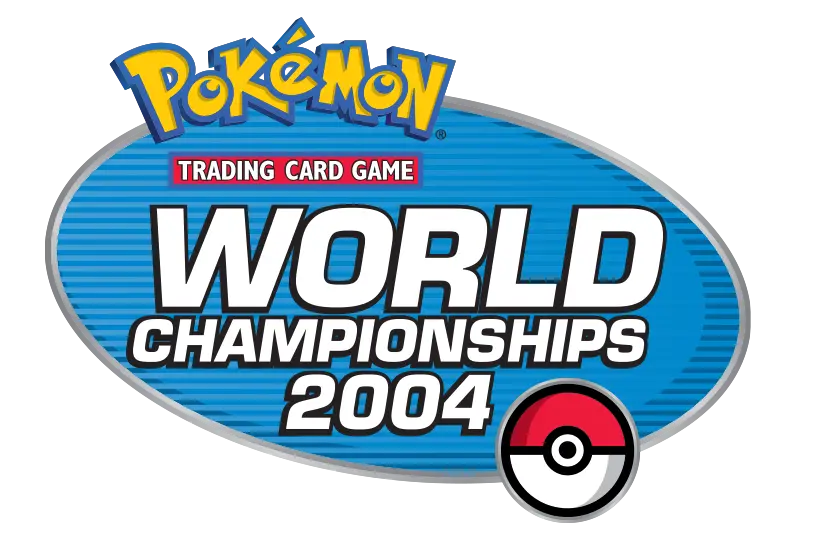
The Lizardon Mega Battle (also known as the Charizard Mega Battle, as Charizard’s Japanese name is Lizardon), was the second official Pokemon TCG tournament. Since the first official Pokemon TCG tournament only happened at a small scale at the World Hobby Fair, the Lizardon Mega Battle was often billed as the “First Official National Championships”.
It was the largest Pokemon TCG event ever held up to that point with an attendance of over 21,500 people, and still remains one of the largest in modern times. The Lizardon Mega Battle was held on April 26, 1998. The tournament returned to the venue of the first official Pokemon TCG tournament, the Makuhari Messe in Chiba, Japan.
The event was the first major Pokemon TCG national championships, and is perhaps the most well-documented Pokemon TCG event of the pre-2000s era due to a commemorative photo book that was published after the event.
Many of the scans and imagery in this article are sourced from that photo book, copies of which have become increasingly rare and expensive. Credit for taking the time to individually scan and upload each page of this 120-page book go to poke_chaos.
Regional Qualifiers
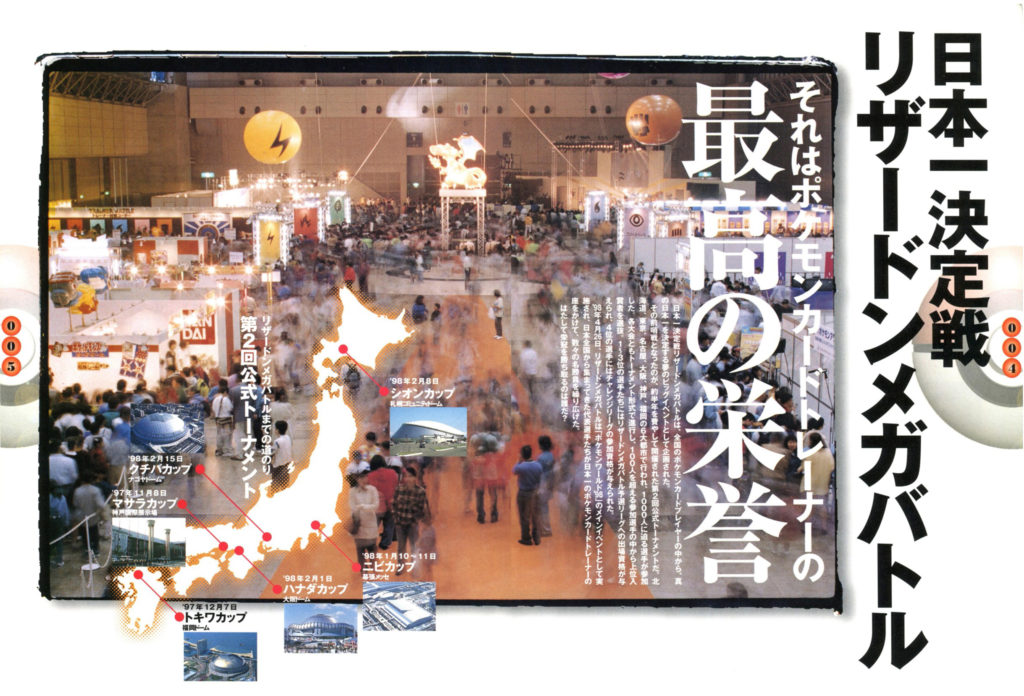
A series of qualifying tournaments were held across 6 locations in Japan from November 8, 1997 to February 15, 1998. This would later be known as the 1st official tournament series. Some of these tournaments had multiple sessions of junior league players. Each of these tournaments was named after the it’s location in the real world, and a town / city from the Pokemon video games.
- Kobe Masara (Pallet) Cup: November 8, 1997 at the Kobe International Exhibition Hall. The junior league had both a morning and afternoon session.
- Fukuoka Tokiwa (Viridian) Cup: December 7, 1997 at the Fukuoka Dome
- Tokyo Nibi (Pewter) Cup: January 10-11, 1998 at the Makuhari Messe. The junior league had an afternoon session on Jan 10, and both morning and afternoon sessions on Jan 11.
- Osaka Hanada (Cerulean) Cup: February 1, 1998 at the Osaka Dome
- Sapporo Sion (Lavender) Cup: February 8, 1998 at the Sapporo Community Dome
- Nagoya Kuchiba (Vermilion) Cup: February 15, 1998 at the Nagoya Dome.
Due to attendance limitations, entry into each regional qualifier was chosen by lottery if there were too many attendees.
Format
Similar to the first official tournament, players at each regional tournament competed in single elimination knockout tournaments to determine winners for each cup. For the Kobe Masara and Fukuoka Tokiwa Cup, the winning players had to win 5 games in a row. For the Tokyo Nibi Cups and onwards, players had to win 6 games in a row. This was likely because organizers wanted to increase capacity after overwhelming attendance at the first 2 tournaments.
Attendees were divided up into juniors and seniors divisions, with juniors being kids in elementary school, and seniors being kids from junior high to high school.
Games were played with the following rules:
- 4 prize cards
- 10 minute time limit per game
- Players could use cards up to the Team Rocket Expansion, but could only use up to 6 cards from the expansion
- Players could use up to 4 cards from Expansion Sheet 1 (the first vending machine series)
- Even though the Leader’s Stadium (Gym Heroes overseas) had been recently been released, players were not allowed to use cards from it.
- Minor rules changes in 1998 from the original TCG’s 1997 tournament ruleset.
Winners
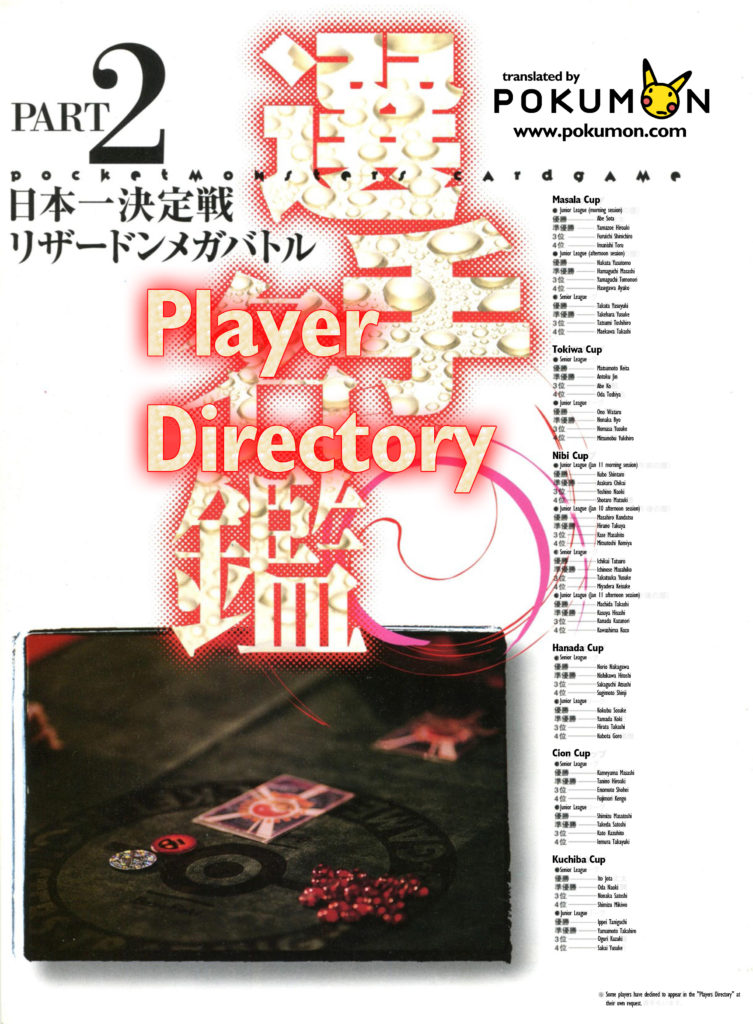
The top 3 players at each cup from each age division received No.1 – 3 Trainer cards. While 4th place was invited to the national championship match, they did not receive a trophy card. In total across all the tournaments, there were 9 junior league tournaments, and 6 senior league tournaments. that means there are 15 copies of the No.1 – 3 trophy cards.
The cards were presented in acrylic plaque which designated the cup that they were awarded at. For more information on how these plaques and trophy cards differed from those awarded at the first official tournament, read here.
The top 3 winners of each tournament earned an invite to the Lizardon Mega Battle national championships to be held on April 26, 1998. The fourth place winners were also invited to the event, but had to play for a spot in the championship spot on the day of the event.
Each winner was also awarded with champion’s baseball cap. This hat would later be mandatory to wear while playing in the Lizardon Mega Battle.

Venue
The Lizardon Mega Battle was larger than any previous Pokemon event. It featured an event stage, several side event corners, and huge decorations across the venue. While the first official Pokemon TCG tournament only took up a large booth exhibit at the World Hobby Fair, the Lizardon Mega Battle occupied an entire convention center hall at the Makuhari Messe. Specifically, the event was held in Exhibit Hall 3.
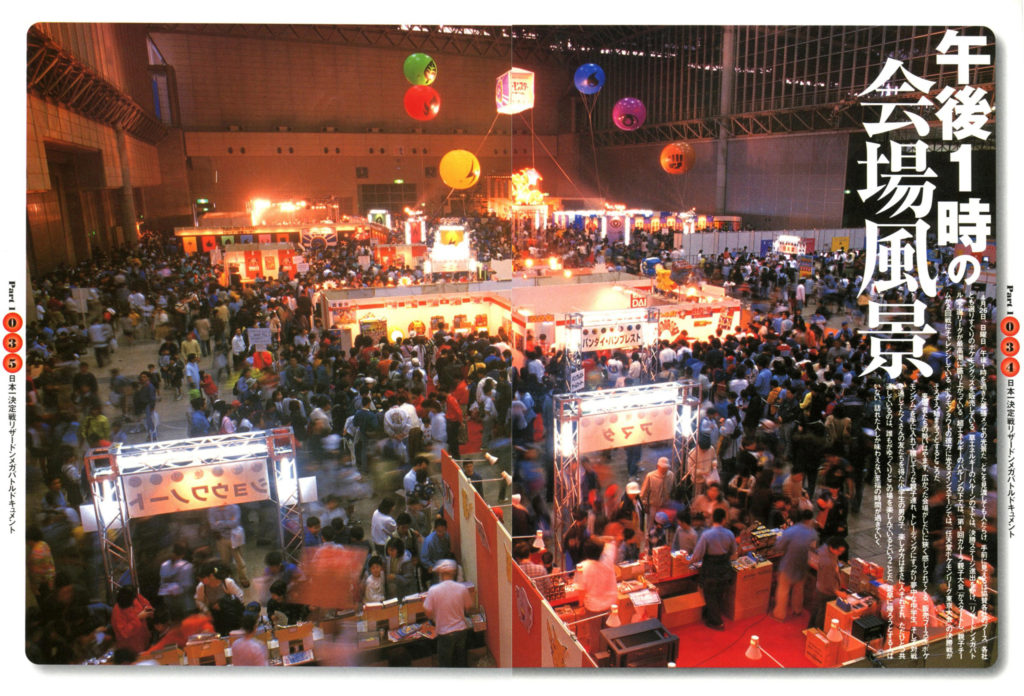
The day before the tournament started on April 25, 1998, workers and staff members began work in the early morning to set up Exhibit Hall 3 for the event at 8:00 AM local time. Performers and musicians began to rehearse at around 5-6 PM, and set-up efforts continued until midnight.
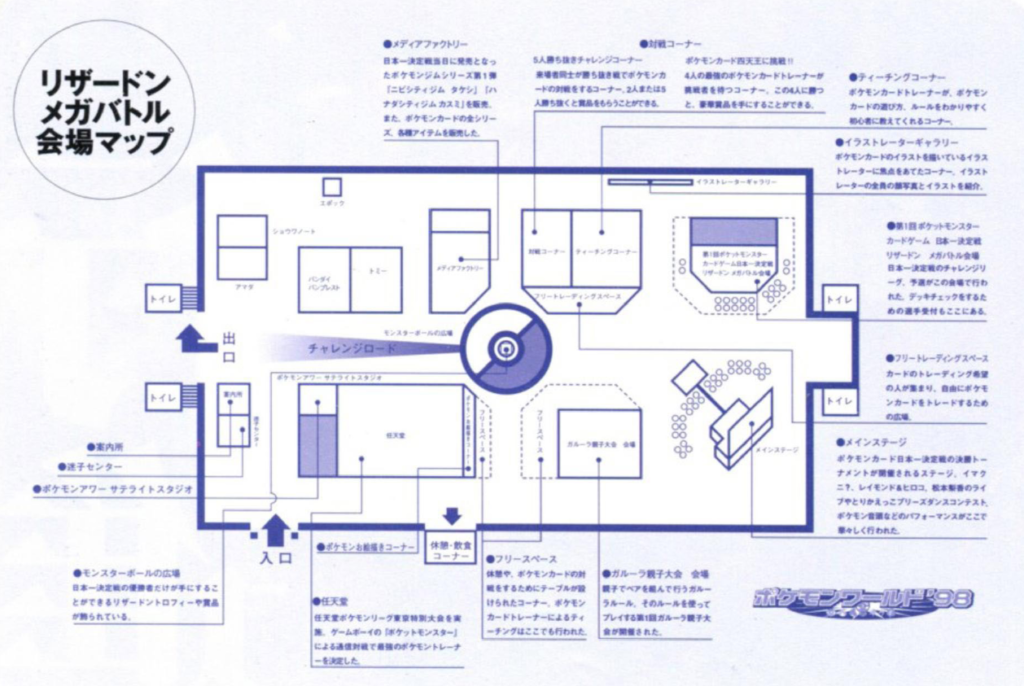
Event Schedule

There were 3 phases, known as “leagues” in the main tournament. First was the Challenge League, in which the 4th place winners from each of the regional tournament players for a spot in the Qualifying League.
The Qualifying League was where players battled to decide who would enter the Final Tournament, which would result in a crowned winner.
During this time, side events at various “corners” ran concurrently to the main tournament. In addition, there were musical and dance performances throughout the day to entertain attendees.
Challenge League
On April 26, 1998 at around 9:00 AM local time, the first part of the Lizardon Mega Battle began with what was known as the Challenge League.
The 4th place winners from each of the 7 regional tournaments were the participants for this portion of the tournament. There were 7 players in the juniors league, and 5 in the seniors league. It’s unknown why there were fewer seniors league 4th place players invited. Out of the total 12 players in the Challenge League, only 5 (3 juniors, 2 seniors) would proceed to next part of the tournament, the Qualifying League.
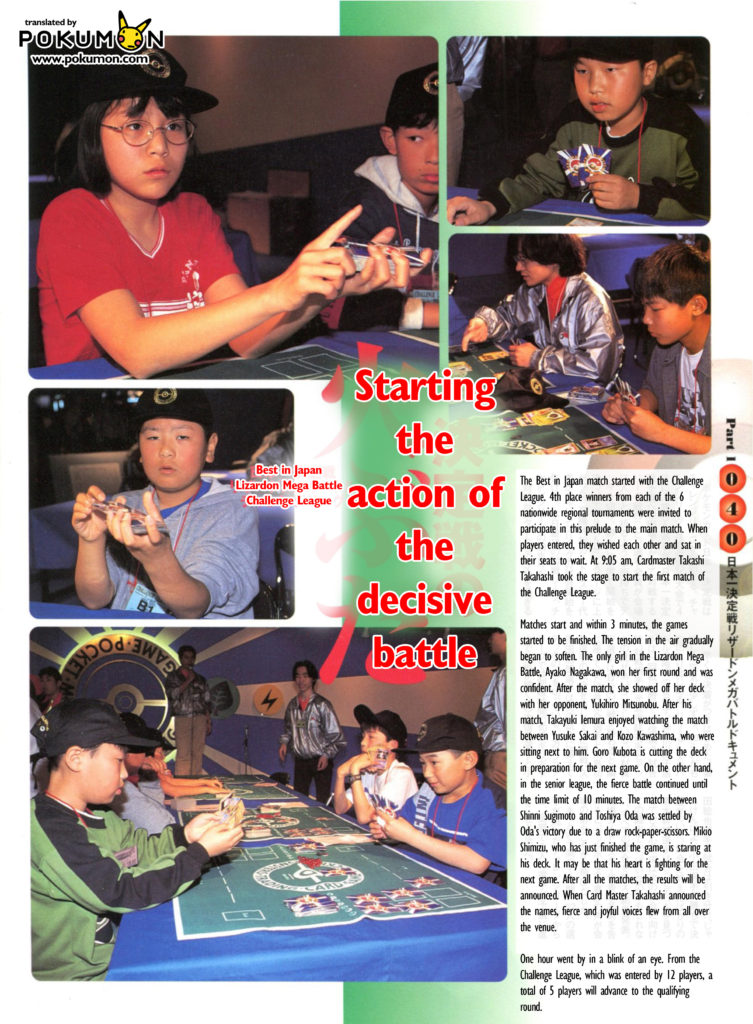
The 7 junior league players were split into 2 “blocks”: A Block and B Block, while the 5 senior league players remained in a single group. Each group of players played in a round-robin tournament, where each player played each other player in their group once. Based off the match records from this round robin, the 5 winners who would move on to the qualifying league were decided.
Within the Challenge League, the only girl player to attend the Lizardon Mega Battle, Ayako Hasegawa, played in one of the junior league blocks. While she won her first match, she ultimately did not make it through the Challenge League. Hasegawa was the first female player to compete in a national championship for the TCG.
After all players had played their matches, wins were tallied and the 5 players who would advance to the Qualifying League had been decided.
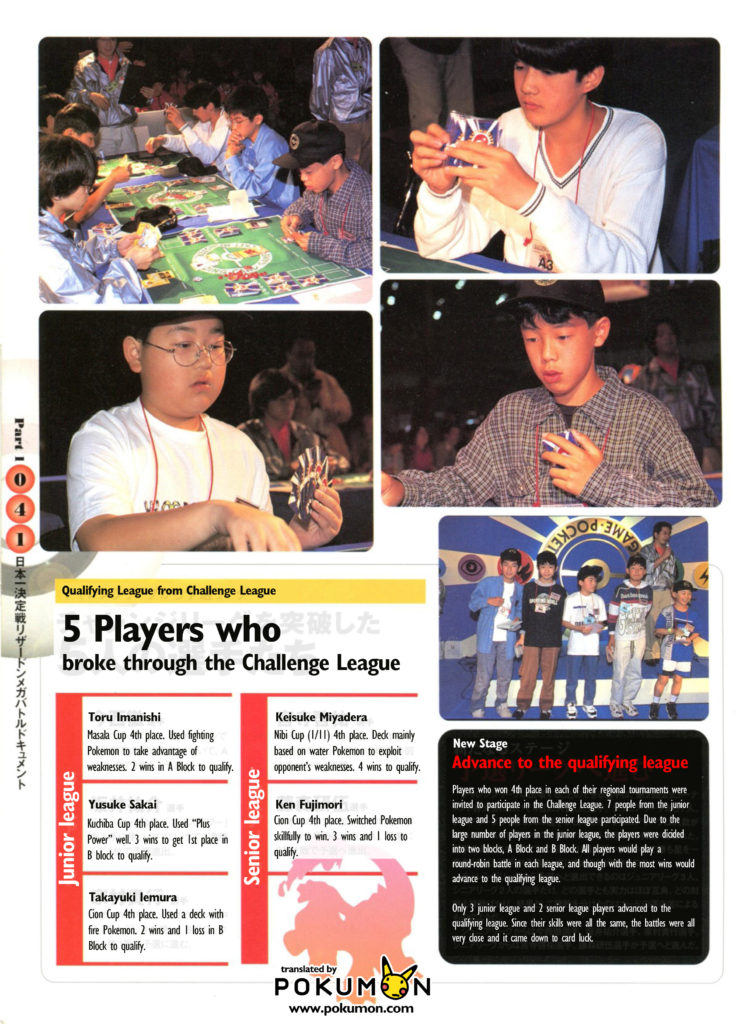
The 3 junior league players who advanced were Toru Imanishi, Yusuke Sakai, and Takayuki Iemura. The 2 senior league players were Keisuke Miyadera and Ken Fujimori.
Qualifying League
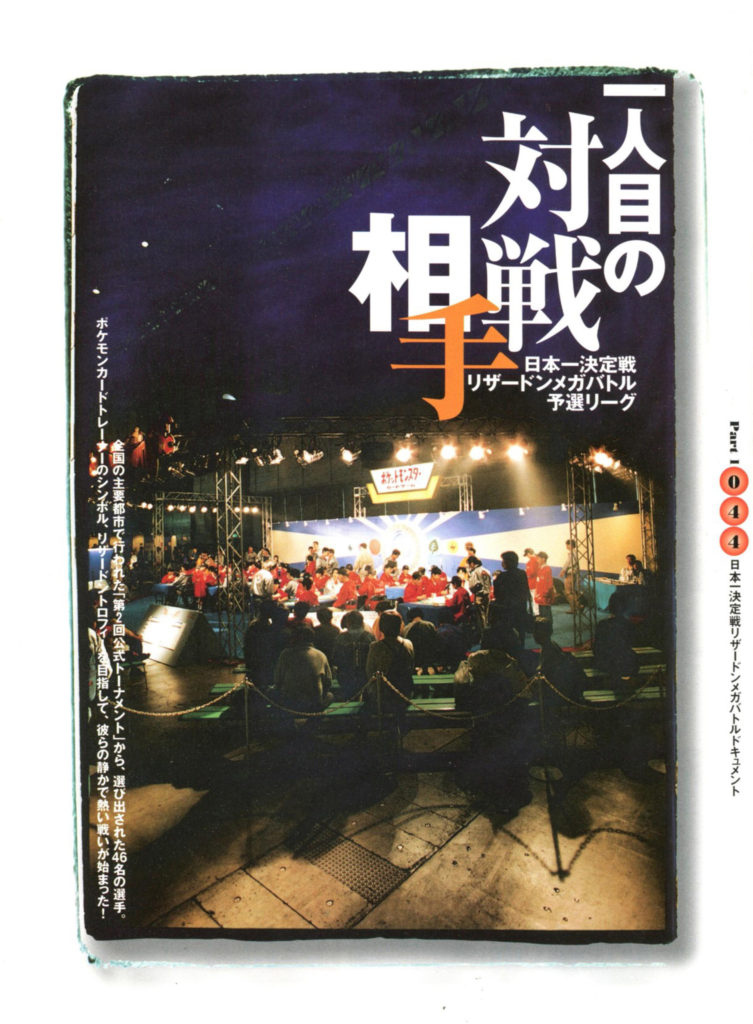
Shortly after the Challenge League had finished The Qualifying League began. At 9:30 AM local time, Qualifying League players were admitted to the event stage to much fanfare. Their decks had been checked and registered while the Challenge League matches were going on. Participants were escorted by staff members to the stage and announced to the venue.
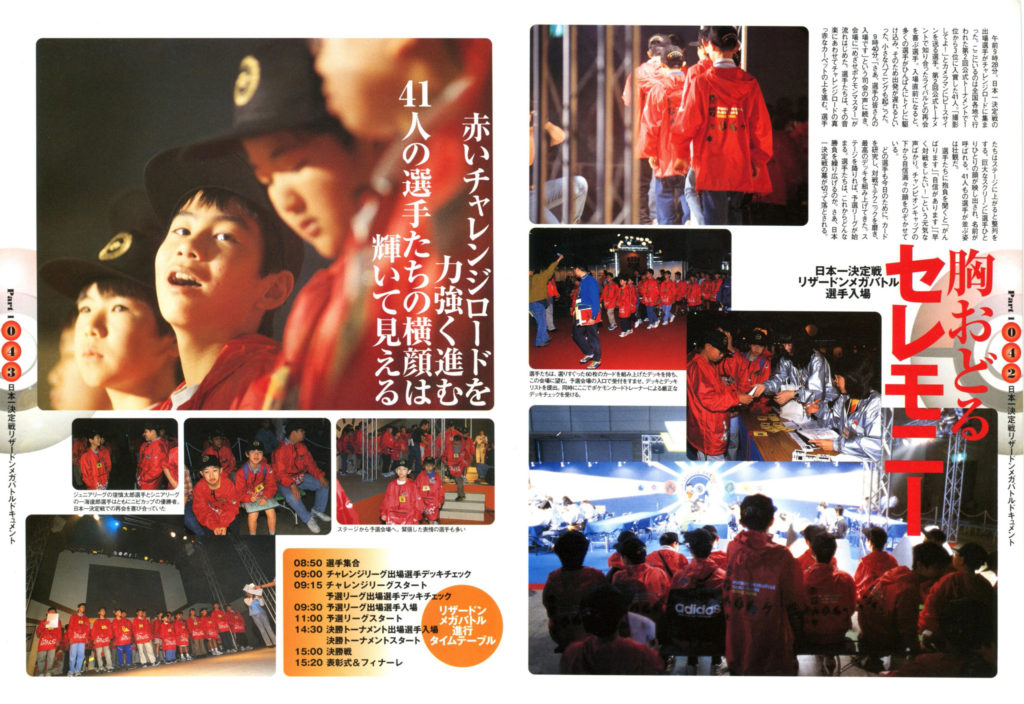
All players who made it to the Qualifying league were given an exclusive red parka. designed by Yusuke Shimizu of SLP Designs. This parka featured various energy symbol and Poke Ball designs on the front and back, and its bright red color was meant to pay homage to the tournament’s mascot, Charizard.
All players were instructed to wear this jacket alongside the previously issued champion cap. for the remainder of the tournament. Due to this, the parkas and caps are featured heavily in all event photos after the Qualifying Tournament.
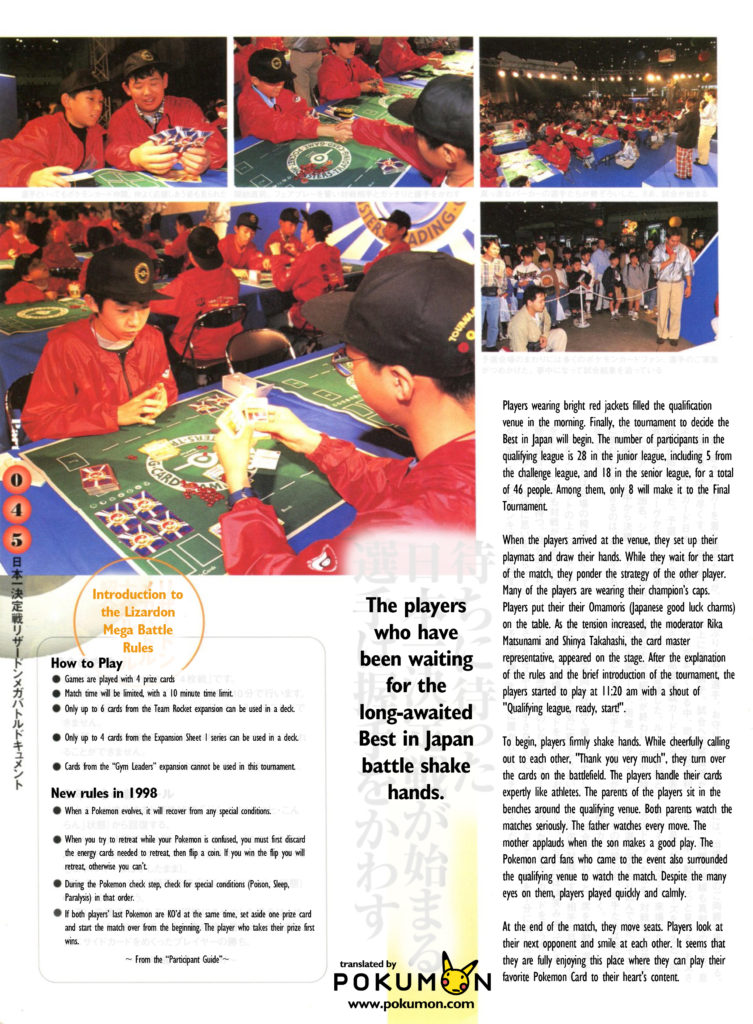
In total, the Qualifying League had 46 players:
- 25 junior league players from placing 1st – 3rd at regional tournaments
- 16 senior league players from placing 1st – 3rd at regional tournaments
- 3 junior league players from the Challenge League
- 2 senior league players from the Challenge League.
It’s evident from these numbers that not everyone from the regional tournaments was able to make it to the national championships, as with 9 junior winners and 6 senior ones, there should be 27 junior league players and 18 senior league players before any of the additional Challenge League ones.
Only 4 players from each of the junior and senior leagues would make it to the single elimination Final Tournament.
Players were split up into 4 groups (known as “blocks”) in each age division. These blocks were named A Block, B Block, C Block, and D Block. Within each block, players played a similar round-robin tournament like they did in the Challenge League, meaning that each player played everyone else in their block once.
Games were fast-paced, with the average match time being 5 minutes and 30 seconds. After all matches had been played, the player with the best overall win record in each block would advance to the Final Tournament. This resulted in 4 finalists for junior league, and 4 finalists for senior league.

The 4 finalists for each age division were as follows:
Junior League Finalists
- A Block: Kazuto Kato (Cion Cup 3rd Place)
- B Block: Sosuke Kokubu (Hanada Cup 1st Place)
- C Block: Takashi Hirata (Hanada Cup 3rd Place)
- D Block: Shintaro Kubo (Nibi Cup 1st Place).
Previously placed 3rd at the 1st Official Tournament
Senior League Finalists
- A Block: Yasuwuki Takata (Masara Cup 1st place)
- B Block: Hiroaki Tanino (Cion Cup 2nd place)
- C Block: Tatsuro Ichikai (Nibi Cup 1st place).
Previously the only senior winner at the 1st Official Tournament - D Block: Naoki Oda (Kuchiba Cup 2nd place)
Final Tournament
With the winners of the Qualifying tournament decided, the Final Tournament began. At 2:36 PM local time, the event stage changed into the main stage for the finalists to play their last games.
Each of the 4 winners for each of the age divisions paired up and played a single match to decide who would advance to the finals, and who would play for 3rd place.

The junior and seniors matches took place one after another. Each of the semi-finalists were seated at one of two tables coated in silver cloth. In between the two tables, 3 commentators narrated the games. A pair of monitors (one for each table) were placed on the floor in front of this commentator desk that had an overhead view of both games.
The 3 commentators were Masako Uchiyama (staff member on the Pokemon TCG), Tsunekazu Ishihara (creator and general producer of the Pokemon TCG), and Shinya Takahashi (Pokemon “Cardmaster” aka a head judge).
The juniors matches would happen first, and the seniors matches would take place directly after.
Junior Semi-finals A vs B
Kazuto Kato (champion of the junior league A Block) and Sosuke Kokubu (champion of the junior league B Block) were the first pair of junior league players in the semifinals.
Kato ran a Grass & Colorless Pokemon deck focused on basic Pokemon with large pools of HP like Chansey, the promotional Hungry Snorlax, and Scyther. It also included Fossil’s Grimer and Muk to shut down Pokemon Powers.
Kokubu’s deck on the other hand was a more traditional “Beatdown” deck with Hitmonchan, Scyther, and Electabuzz. It heavily utilized aggressive cards like PlusPower to end games early.
The game started with both players putting their Scythers in the active spot. However, Kokubu had no other benched Pokemon, while Kato had a Chansey on the bench.
Kokubu quickly gained a lead and took 3 prize cards while Kato only had taken 1. The match ended within 5 minutes with Kokubu’s victory, despite Kato’s efforts at stabilizing the game board by filling his bench with multiple Hungry Snorlaxes.
Junior Semi-finals C vs D
Takashi Hirata (champion of the junior league C Block) and Shintaro Kubo (champion of the junior league D Block) were the second pair of junior league players in the semi-finals.
Hirata ran a Wigglytuff deck that utilized the Pokemon’s “Do the Wave” attack, which grew in power for each benched Pokemon. In addition to this, the deck also ran multiple high-HP basic Pokemon like Chansey and the promotional Hungry Snorlax. Lastly, Hirata’s deck utilized Fossil’s Aerodactyl to shut down all Pokemon evolutions.
In contrast, Kubo ran a traditional “Rain Dance” deck. This deck used powerful water basic Pokemon like Articuno and Lapras, and centered around evolving a Squirtle as quickly as possible to Blastoise to quickly fuel energy costs. Instead of the standard Base Set Squirtle, Kubo used the one from the first Expansion Sheet, as it had more HP. The Squirtle released in the Team Rocket expansion also had 50 HP, but since players were restricted to only using 6 cards from that expansion, it didn’t make sense to use those spots on a Pokemon that was only used as a evolution path to Blastoise.
The game started off poorly for Kubo, as he was only able to start with an Articuno in the active spot and no Squirtles at all. It was critical for his deck to have a Squirtle out early to evolve into Blastoise quickly.
On the other hand, Hirata had a very strong starting state, with an active Jigglypuff and a Mysterious Fossil on the bench. His hand contained an Aerodactyl to shut down Squirtle’s evolutions, as well as multiple trainers like Computer Search and Professor Oak to easily enable his deck’s game plan.
On his first turn, Kubo immediately used his Professor Oak to draw a new hand (he did it so quickly that commentators weren’t able to see the last 3 cards in his hand). After successfully finding a Squirtle, he placed it on the bench and prepared to evolve it.
Unfortunately for Kubo, on his second turn, Hirata used his Computer Search to find a Wigglytuff and evolved his active Jigglypuff. He then evolved his Mysterious Fossil into an Aerodactyl, making Kubo unable to evolve his Squirtle into Blastoise.
by the 5th turn, Hirata had taken 3 prize cards while Kubo had taken none. The match ended with Hirata’s victory.
Seniors Semi-finals A vs B
Yasuyuki Takata (champion of the senior league A Block) and Hiroaki Tanino (champion of the senior league B Block) were the first pair of senior league players in the semifinals.
Takata’s deck was an aggressive Electric Pokemon-focused deck that also featured several powerful colorless attackers. It features some unconventional basic Pokemon like Voltorb from the Team Rocket expansion and Jungle’s Spearow. These unassuming Pokemon were backed by a powerful suite of disruptive trainer cards like Super Energy Removal.
Tanino’s deck was a traditional “Energy Trans” deck, which centered on using Base Set’s Venusaur’s Pokemon Power to manage energy costs. It featured Fossil’s Ditto as a flexible card that could copy the opponent’s Pokemon, as well as the standard set of trainer cards like Bill and the promotional Super Energy Retrieval.
The game started with Takata having an Electabuzz in the active spot, and Tanino with a Ditto in the active spot along with a Bulbasaur on the bench.
Over the course of the game, Takata was continually able to disrupt Tanino’s efforts to stabilize. This included a highlighted play during which he switched a Spearow into Tanino’s active Ditto that already had 60 damage on it. This caused Ditto to transform into the 50 HP Spearow and immediately be knocked out.
The match ended with Takata’s victory after over 10 turns of back and forth.
Seniors Semi-finals C vs D
Tatsuro Ichikai (champion of the senior league C Block) and Naoki Oda (champion of the senior league D Block) were the second pair of senior league players in the semifinals.
Ichikai and Oda both ran very similar beatdown decks that featured cards like Jungle’s Scyther, Fossil’s Magmar, and disruptive trainers like Rocket’s Sneak Attack.
Since the game was essentially a mirror match, much of it came down to luck. Ichikai started in an advantageous position, with an active Magmar against Oda’s Scyther. Both players started with an Electabuzz on the bench.
The game between both players was very evenly matched, with both players coming down to their final prize card. On the 14th turn, Ichikai managed to use a combination of tactically retreating his Pokemon as well as using Gust of Wind to score the last prize card. It’s worth nothing that during the time this tournament was held, players were allowed to retreat Pokemon as many times as they wanted during their turns. In the modern rules of the TCG, players are limited to one retreat per turn.
3rd Place Playoffs
With the semi-final matches decided, the losers of each match would play each other to determine 3rd place.
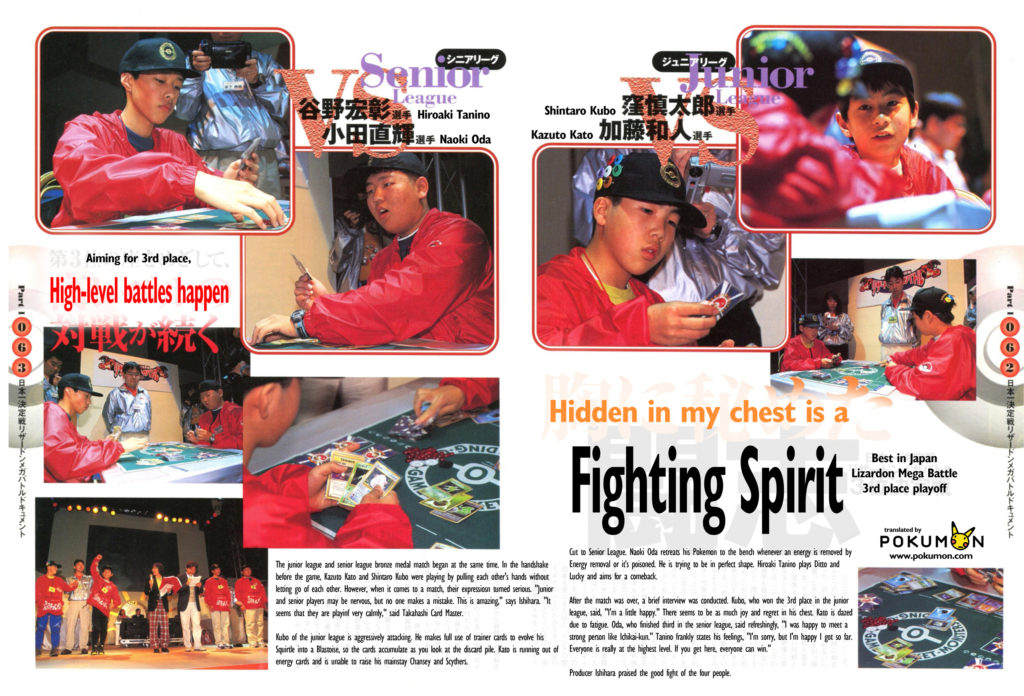
For the junior league, this meant that Shintaro Kubo would face off against Kazuto Kato.
Kubo’s “Rain Dance” deck had an unfavorable matchup against Kato’s Grass and Colorless deck, especially since Kato utilized Muk’s Pokemon Power “Toxic Gas” to turn off Pokemon Powers like the Blastoise’s eponymous “Rain Dance”. Kubo got off to a rocky start and only had a Mr. Mime from Expansion sheet 1 as a basic Pokemon. This card was meant as a supporter card, not a Pokemon that would be put into the active spot.
However, after multiple turns of back and forth, Kubo was able to evolve multiple Squirtles into Blastoises. By the 10th turn, Kubo had taken 3 prize cards, while Kato had not taken any. Kubo ended up winning the match, cementing his position as 3rd place in the junior league.
In the senior league’s 3rd place playoff, Naoki Oda would face off against Hiroaki Tanino.
Oda ran an aggressive beatdown deck that featured Fossil Magmars. Tanino ran a slower “Energy Trans” deck with Grass and Colorless Pokemon, which meant that Tanino was at a particular disadvantage due to weakness typing.
Despite this uphill battle, Tanino put up a strong defense utilizing Chansey, Ditto, and Pokemon Center. However, in the end Oda was victorious. By the 13th turn, Oda had taken 3 prize cards while Tanino still had not taken any. Oda would therefore be crowned with 3rd place in the senior league.
Tournament Finals
At approximately 3:15 PM local time, the 3rd place playoff matches had concluded and it was finally time for the final matches. A pair of golden tables and chairs were brought out on stage to replace the silver ones that players had previously been playing on.
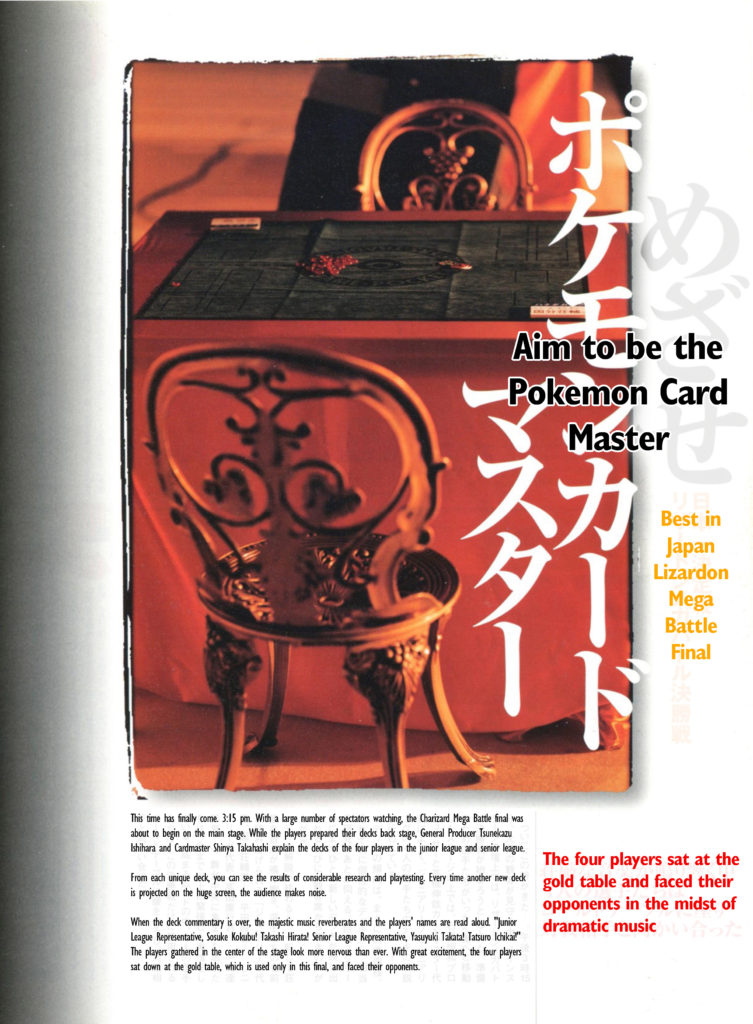
While the finalists from each age division prepared back stage, the 3 commentators showed the decklists of each finalist on the event stage’s giant projector screen. After the explanation of each player’s decks had been concluded, the 4 players sat down at the golden tables, and the finals began.
Both the junior league and senior league games would occur simultaneously.
Junior League Finals
Sosuke Kokubu (1st place, Osaka Hanada Cup) and Takashi Hirata (3rd place, Osaka Hanada Cup) would face each other in the juniors finals. Even though both competitors were from the same regional tournament, they ran different decks.
Kokubu ran a traditional “Beatdown” deck with Hitmonchan, Scyther, and Electabuzz. It heavily utilized aggressive cards like PlusPower to end games early. In contrast, Hirata ran a Wigglytuff deck that utilized the Pokemon’s “Do the Wave” attack, which grew in power for each benched Pokemon.
Despite the prestige of being the final matchup, the junior league championship match was one of the shortest of the Final Tournament.
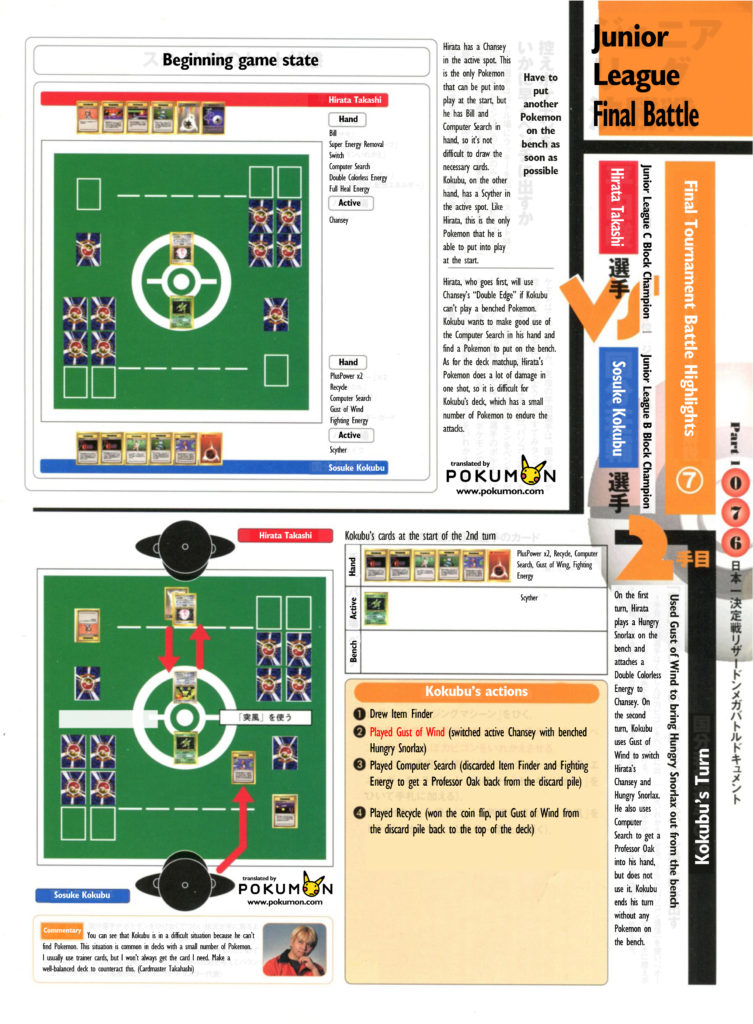
The match began with both players only having a single active Pokemon, with none on the bench. Hirata had a Base Set Chansey, while Kokubu had a Jungle Scyther.
On the first turn, Hirata played a Hungry Snorlax promo card onto the bench, and attached a Double Colorless Energy to Chansey. This was dangerous for Kokubu, because if Hirata attached another Double Colorless Energy to Chansey, it could use its Double-Edge attack and knock out Scyther. Since Scyther was Kokubu’s only Pokemon, he would then immediately lose the game.



On Kokubu’s turn, he played Gust of Wind to switch Hirata’s active Chansey and his benched Hungry Snorlax to avoid losing the game immediately. His hand had no other basic Pokemon, but did have a Computer Search trainer which he could use to find a Professor Oak to reset his cards. However, he also had 2 PlusPower trainers that he wanted to keep, so instead of using Computer Search to find Professor Oak and draw a new hand, he opted to end his turn after switching Hirata’s Pokemon and using Recycle to get back a Gust of Wind
This proved to a fatal mistake. On Hirata’s turn, he played a Switch trainer card to put Chansey back into the active spot, attached a Double Colorless Energy, and used Double-edge to knock out Kokubu’s Scyther in one attack. The juniors league championship match would end moments after it had began, with Hirata being crowned the champion.
Senior League Finals
Tatsuo Ichikai (1st Place, Tokyo Nibi Cup) faced off against Yasuyuki Takata (1st Place, Kobe Masara Cup) for the championship match of the senior league.

Ichikai ran a traditional “Beatdown” deck similar to the one run by junior league’s Kokubu, but it also featured Fossil’s Magmar. Takata also ran an aggressive deck, but used some unconventional Pokemon like Voltorb and Machop from the Team Rocket expansion.
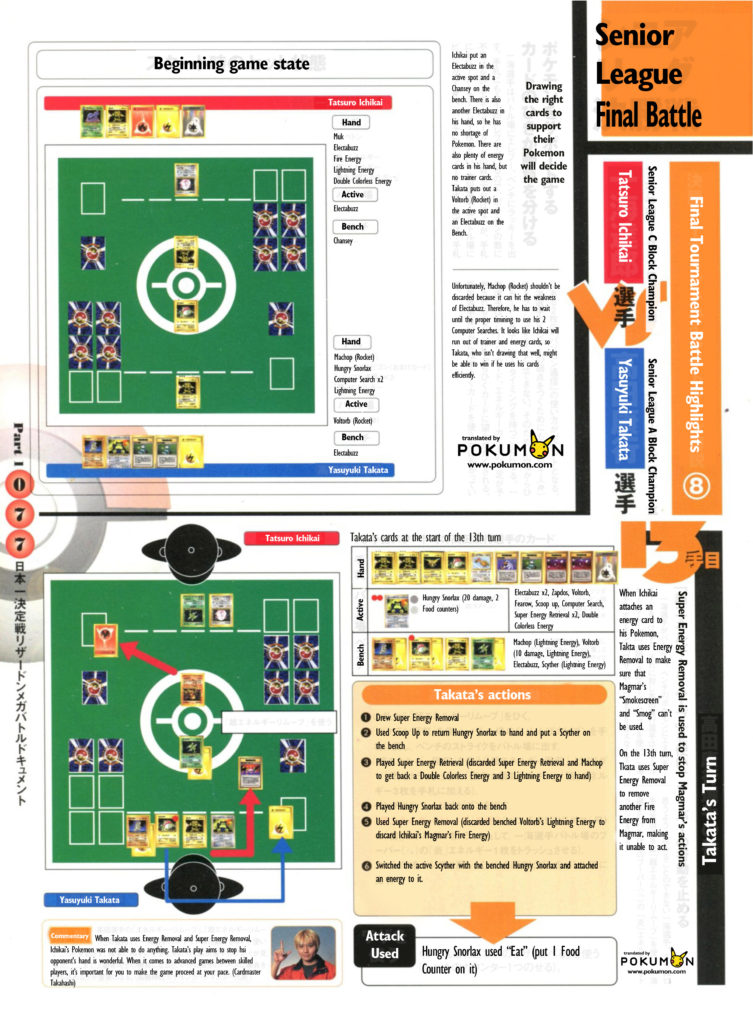
Unlike the junior league final which was decided within the first few turns, the senior league championship match lasted the full time limit of the match, with both players trading blows back and forth.
Ichikai started the game with a Base Set Electabuzz in his active spot, while Takata started with a Team Rocket Voltorb. Takata aggressively used Energy Removal and Super Energy Removal to deny Ichikai the ability to power up his Pokemon while continuing to attack with his basic Pokemon.
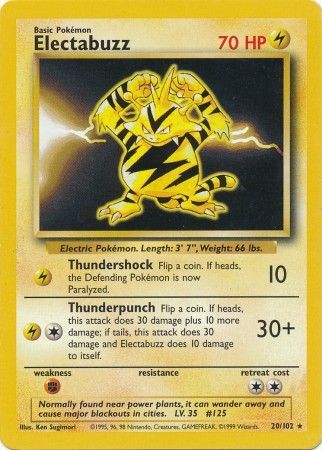
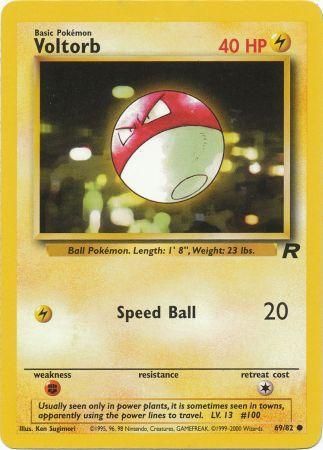
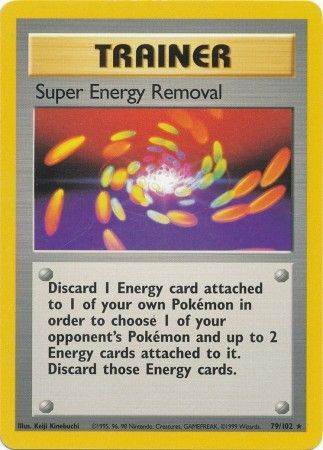
As the time limit neared, Takata had taken 2 prize cards, while Ichikai still hadn’t taken a single one. As the moderator began to count down the final seconds of the game, Ichikai conceded the game, crowning Takata as the senior league champion.
Awards Ceremony
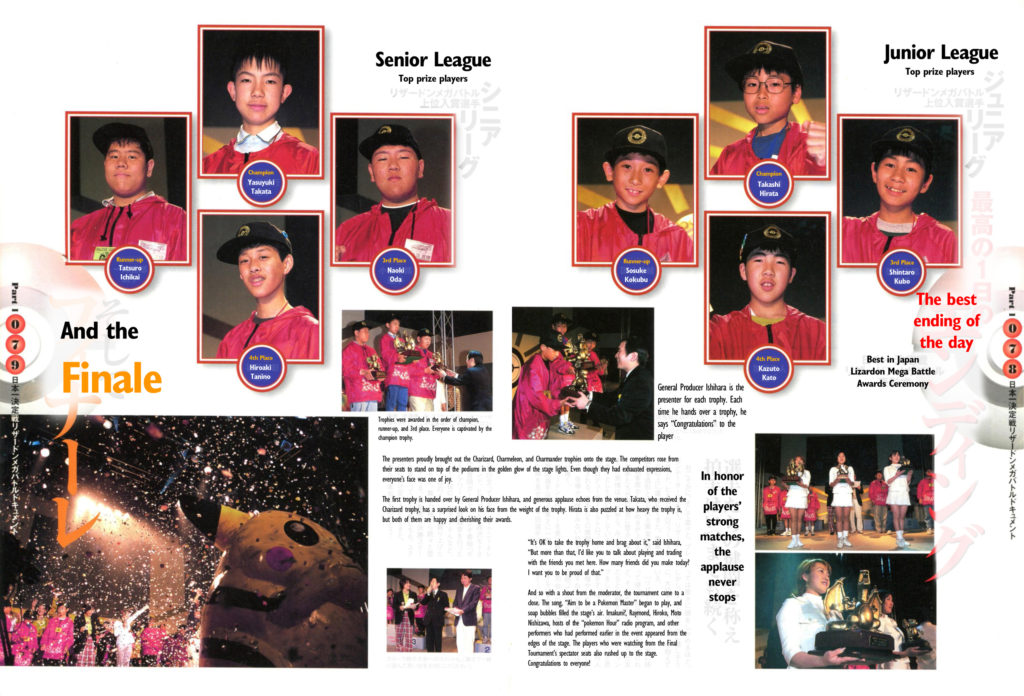
After the championship matches, the main stage hosted the awards ceremony. Each of the top 3 winners for the junior and senior league were presented with a Charizard (1st place), Charmeleon (2nd place), or Charmander (3rd place) trophy by Ishihara.
The trophies featured a latex sculpture of the Pokemon atop a wooden base with a felt bottom. They were made by Takara Tomy Co. Ltd, a Japanese toys manufacturer.
As each winner was presented with a different trophy depending on their placement, there are only 2 copies of each trophy in existence.
After the trophy presentation, the performers like Imakuni who had entertained attendees as well as other staff members came on to the stage to do a final performance amidst confetti, soap bubbles, and music. Thus concluded the 1998 Lizardon Mega battle.
Champion Interviews
After the event, both the junior and senior league champions were interviewed. This provided insight into their full deck lists, as well as their journeys to becoming crowned national champions.
These interviews revealed some interesting insights:
- The junior league champion (Takashi Hirata), went completely undefeated in both the Qualifying League and Final tournament. Meanwhile, the senior league champion (Yasuyuki Takata) lost a single game during the Qualifying League.
- Takata’s family had a complete ban on video games, meaning that it was hard for him to acquire copies of the powerful Hungry Snorlax promo card, which was bundled with purchases of Nintendo 64s in a campaign. He traded a friend for the only copy in his deck.
- Hirata pranked his mother when he got home and pretended he hadn’t won the championship by leaving the Charizard trophy outside the front door.
- Both winning decks ran very similar lists of trainer cards
- Takata’s deck utilized unconventionally “weak” Pokemon like the Team Rocket expansion’s Voltorb and Machop. No other decks in the Final Tournament ran these cards.
- Hirata’s deck ran only 9 energy cards total.
Side Events
The Lizardon Mega Battle featured multiple side events for attendees to participate in while the main tournament was running. These were known as “corners”, and would go on to become staples of all future official tournaments.
Teaching Corner
At the teaching corner, staff members were present throughout the day to teach players how to play the Pokemon TCG.
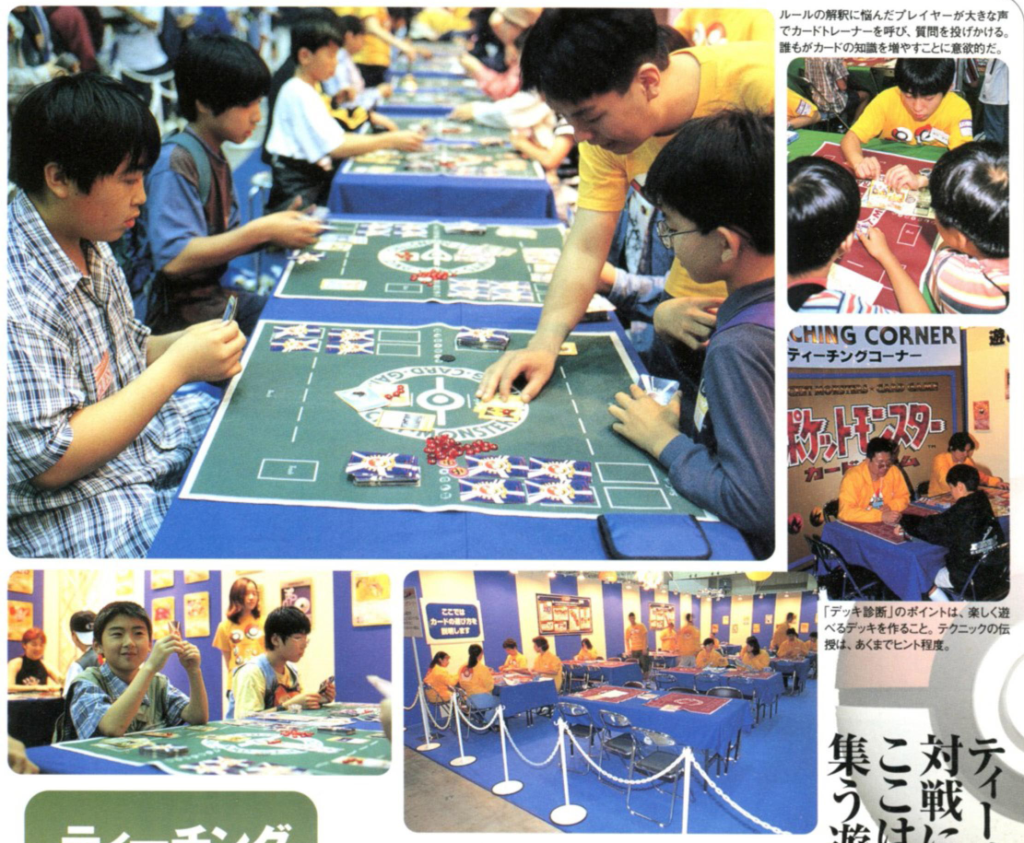
Free Battle Corner
Like other official events, this corner was a free battle area where players could challenge each other to games. In normal official events, winners would be awarded with small metal badges with energy symbols on them.
However, at this event there were additional prizes. If a player won 2 times, they were give a random unpeeled sheet from Expansion Sheet 1, the first vending machine set. At 5 wins, players were given product from the new Gym Heroes expansion set and other prizes.
In addition, this corner featured special tables where attendees could challenge one of the “Four Heavenly Kings”, who were players who had the previous 1st Official tournament. Attendees could get a numbered ticket to play against them, but all tickets were gone by 11 am, so there was a long line to play them.
Free Trading Corner
This was an area in the venue where players could gather and trade cards. At a large event like this, it was completely packed with attendees asking for trades.
Pokemon Card Museum
A museum that highlighted the history of the Pokemon TCG was set up at the event. It featured over 500 cards from the Base Set to the Team Rocket Expansion in glass cases.
Pokemon Drawing Corner
This corner was a series of blank paper canvases with drawing supplies for attendees to draw Pokemon on. Staff members would put out new paper as the canvases filled up, but children were drawing so quickly that they had trouble keeping up.
Pokemon Illustrator Gallery
This gallery had a piece of artwork for each Pokemon TCG illustrator, including those who had won the first Pokemon Illustration contest. Under each piece of artwork was a photo and biography of the illustrator. In total, 19 illustrators were exhibited here.

1st Official Kangaskhan Parent-Child Tournament
One of the most anticipated side events was the 1st Official Kangaskhan Parent-Child Tournament. This event paired up adults and children (they didn’t necessarily have to be parent and child) in a 2v2 tag team tournament.

They would be playing with the brand-new “Kangaskhan Rule” and utilizing a new “Touch Change!” trainer card. This card would continue to be distributed at future Parent-Child tournaments, and also through the Pokemon Card Fan Club Magazine.
38 parent-child teams gathered at 11:47 local time. They would play 4 games of swiss amongst the teams, with points being scored for wins. At the end of the 4 rounds, the top 8 teams would advance to the finals.
The finals of the Parent-Child tournament came down to a parent-child team (Ryoichi & Yasuhito Kajiwara) against an aunt-nephew team (Eiko Fujimoto & Yukitaka Kibata). In the end, the Kajiwara parent-child team won, and received a one-of-a-kind Kangaskhan plush trophy designed specially by Dr. Ooyama.

All participants also received a special “Pokemon Dorayaki with a Kangaskhan design on it. Dorayaki is a type of Japanese confection. They consists of two small pancake-like patties made from castella wrapped around a filling of sweet azuki bean paste. There was a dorayaki stand at the venue making dorayaki with Pokemon designs stamped onto them, but this Kangaskhan design was exclusive to participants of this side event.
The top 8 teams each received 1 of the famous Kangaskhan promo cards, and the winning team received 2 copies of the card. More copies of this card would be released later in the year at the Kamex Mega Battle’s Kangaskhan Parent-Child tournament side events.
Performances
Throughout the day, the main stage had live musical performances and danced by a variety of Pokemon celebrities and performers. Imakuni and other musical artists performed songs from the animated series, and there were also dance performances by children groups.
Other Memorabilia
There were many pieces of event memorabilia produced exclusively for the event. In addition to the trophies, participants received parkas, deck boxes, deck bands, carrying bags, and playmats.
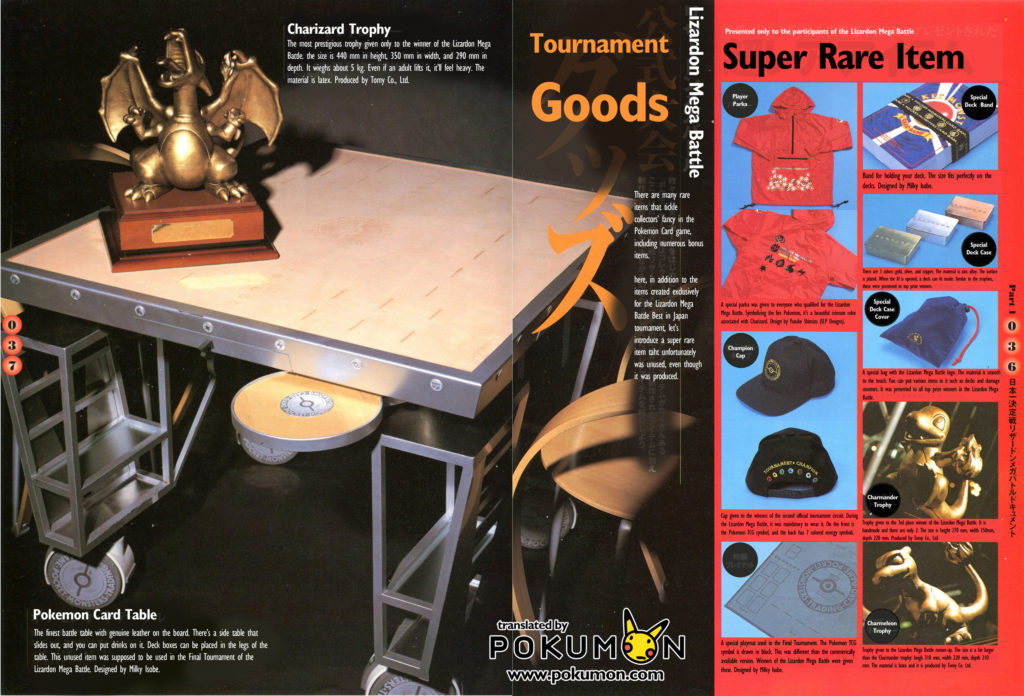
In particular, there was a card table specially designed by Milky Isobe, the original graphic designer for the Pokemon TCG. It features shelves built into its wheeled legs to hold deck boxes, a slide-out cup holder with a Poke Ball motif, and energy symbols built into the metal studs on its side.
The table was meant to be used during the final battle. For reasons unknown, it sadly went unused.
In addition, one of the champions (it’s unknown who) has sold off their Charizard statue, as it currently is in possession of another collector, 149montblanc. The trophy plaques do not distinguish which age group they were awarded to, and only simply designate that they were given to the “champion”.

Legacy
The 1998 Lizardon Mega Battle would become the blueprint for all major national tournaments going forward. Later in the same year, the Kamex (Blastoise) Mega Battle would take place with similar fanfare and structure.

The Lizardon Mega Battle would also go on to directly inspire a 2016 version of the event known as the 2016 Lizardon Mega Battle. While the 2016tournament was updated to fit the more modern tournament structure, it paid homage to the 1998 event with its own golden Charizard trophy.
Sources
- https://www.pokeguardian.com/429334_no-2-trainer-trophy-card-from-1997-sold-for-over-84-000
- Lizardon Mega Battle Commemorative Event book (pages noted above)
- 2000 Official Card Game Guide, pg. 303, 340



